#the film or show adaptations all garner similar feelings do they not
Explore tagged Tumblr posts
Text
I mean I’m kinda not against a lore dump & a quick reveal of Appa in an adaptation. this is a show for existing fans. if we were getting a 1:1 what’s the point? I don’t mind that everything is getting explained real fast so we can jump right in on the ground that I’ve decided to view this exactly how I view book to movie adaptations. I get why this stuff would bug some people but for me this is a little like how I felt watching the Harry Potter movies as they came out after I read the books as they came out. Like ok we’re seeing a new version of our faves it won’t be totally true but that’s ok
#cancel me if you want for loving Harry Potter btw#I love trans people#Harry potter is a cultural phenomena & you’re fake af if you pretend it’s not a huge part of many peoples lives growing up#this is the best comparison I can make#like do you get me#if not Harry Potter cmon#twilight. the hunger games. a series of unfortunate events#the film or show adaptations all garner similar feelings do they not#like this is ok#it’s not the thing I love but that’s ok#rose watches atla la
10 notes
·
View notes
Text
'Adapted from the 1987 novel titled ‘Strangers’ by Taichi Yamada, ‘All of Us Strangers’ is written and directed by Andrew Haigh. Starring Andrew Scott and Paul Mescal in lead roles, the plot revolves around two neighbors who get into a passionate relationship while one of them takes a trip down memory lane and works towards healing from the loss of his parents three decades ago. Upon its premiere, the fantasy romantic drama movie garnered positive reviews from critics and fans alike, potentially igniting an interest in you to learn more about the film.
What is All of Us Strangers About?
Focusing on nostalgia and gay romance, the narrative acquaints us with a screenwriter named Adam who leads a mundane and lonely life in his London apartment. An encounter with a neighbor named Harry turns his whole world upside down, kicking some life into his boring existence. As the two get into a relationship, Adam feels nostalgic about his childhood home and envisions his parents there, living just like they used to when they were alive 30 years ago. To find out what fate has in store for the couple, you will need to watch ‘All of Us Strangers’ yourself; and here are all the ways you can do so!
Is All of Us Strangers on Netflix?
No, ‘All of Us Strangers’ cannot be accessed on Netflix. But thanks to the streaming giant’s extensive content library, you have the option to turn to some other romantic films using your subscription, such as ‘Nuovo Olimpo‘ and ‘Your Name Engraved Herein.’
Is All of Us Strangers on HBO Max?
We hate to break it to you that HBO Max subscribers will have to look for ‘All of Us Strangers’ on other platforms as it is not available on the streamer. But don’t let it stop you from making the most of your subscription and checking out similar movies on HBO Max, including ‘Happy Together.’
Is All of Us Strangers on Hulu?
We bring great news for Hulu subscribers! You can use your subscription to stream ‘All of Us Strangers’ on the platform by heading over here!
Is All of Us Strangers on Amazon Prime?
Although Amazon Prime Video doesn’t house ‘All of Us Strangers’ in its regular offering, subscribers can still purchase the Paul Mescal starrer...Meanwhile, regular subscribers can check out some excellent alternatives on the streaming giant, such as ‘Of an Age‘ and ‘Summer of 85.’
Where to Watch All of Us Strangers Online?
‘All of Us Strangers’ has been released in theaters and is available for purchase on some VOD platforms, including Vudu, iTunes, Microsoft Store, AMC on Demand, Google Play, and YouTube. So, if you wish to get an immersive viewing experience, we recommend you check show timings and book tickets on the movie’s official website and Fandango.'
#Prime Video#Vudu#Hulu#All of Us Strangers#Strangers#Taichi Yamada#Andrew Haigh#Andrew Scott#Paul Mescal
0 notes
Note
Please please do write the post about wwx not being dumb/oblivious. Those posts were just funny at first but somehow it's now become accepted fact. Meanwhile whether cql or mdzs wwx is a very competent, savvy protagonist who's actually pretty observant! It's getting pretty tiring to see him reduced to genki oblivous magical girl (not that I don't like those, it's just wwx is not one).
Hey anon!
I do plan on writing a more elaborate meta post exploring what arguments there are in the novel to support my wwx is not dumb/oblivious agenda.
But for now I just want to address one factor I think plays a big part in shaping the fandom’s perception of wwx as oblivious/dumb, regardless of how wwx was actually written in the novel. That is, the creative liberties taken by (or forced onto) the cql production team, which have had in my opinion two consequences: 1) cql does not manage to establish how quick-witted and savvy wwx is, which is compounded by the fact that it chose to play the troublemaker persona straight 2) the fact that wwx and lwj’s relationship is entirely subtext actually ends up making wwx look oblivious (at least to people applying a queer reading/bl-danmei reading to their interactions--people who are obvious to or choose to ignore the subtext certainly wouldn’t come to the same conclusions).
So, the first issue. In the novel, wwx’s intelligence is more of a focal point in the narrative because it is a crucial part of the dramatic irony/tragedy of his death: as a result it cannot help being more important to the themes of the novel. After all, he is ultimately hunted down because of and killed by his inventions. The man created an entirely new field of cultivation! In cql, this is somewhat lost due to the fact that he does not invent modao nor does he create the yin hufu, and his death is more of a suicide than a sacrifice (i am still not over the fact that he throws the yin hufu at the crowd to let them wage war over it? that’s the complete thematic opposite of his death in the novel...).
The novel, as well, is better at establishing that wwx’s antics are generally not because he’s just being a troublemaker, but that they are a way in which he garners information, gets people to act the way he needs them to or misdirect them. For instance, in cql, when lwj destroys wwx’s (well, nhs’s) spring book in the library, wwx looks genuinely pained and affronted--in the novel, it is clearly shown that, when wwx realized lwj intended to bring the spring book to lqr, he intentionally made him angry so that he would destroy the evidence himself. the point of the prank was also to not only get a reaction out of lwj, but also (reading btw the lines) wwx’s way of trying to leave a lasting impression on lwj now that his punishment was over. Differently put, while wwx can do directionless pranks, more often than not, they have an underlying meaning/goal instead of just being for Attention(TM) in general. In contrast, the web series is full of missed opportunities in terms of characterisation, and is so from the very beginning (I find extremely disappointing how they decided to adapt the mo mansion and dafan mountain arcs because of how important they are to establishing wwx’s character for the readers/viewers. Through these arcs, we get acquainted with the way he thinks and deduces information, and how he uses people’s perceptions of him and others to his advantage. If you can only read English, @pumpkinpaix‘s translation of the first few chapters might help get a better sense of the nuances).
I’m not saying that wwx is portrayed as dumb in cql: but that his characterization is a lot more fuzzy and inconsistent, and that his intelligence is utilized mostly when wwx goes into his detective mode. As a result, I do feel like it undermines how analytical wwx is in all aspects of his life, making it easy to see him as, you know, someone who’s, like, half-smart, half-super-dumb.
As for issue #2, part of it boils down to the fact that most of the obstacles to wangxian’s relationship had to be erased due to censorship. There no longer is homophobia/internalized homophobia to motivate moments of denial or internal conflict; there is no longer the phoenix mountain kiss to explain lwj’s reluctance to respond to wwx’s flirting after his rebirth (as I explored in one of my other meta post); there is no longer lwj’s failed confession and lwj’s mistaken belief that wwx knows of his feelings, etc. These vectors of tension help contextualise and explain why it takes so long for wwx to realize lwj’s feelings towards him (but let’s not forget that he does: after jinlintai, he starts to realize that lwj treats him especially well, which becomes a certainty after the second siege). the cql production team had no choice but to take these elements away.
that being said, by adding new or by changing moments to support the subtext and to please (bl-danmei) fans, the show actually takes away even more vectors of tension/misunderstanding between wwx and lwj, and makes wwx’s crush seem even more obvious and straight-forward. Take for instance the mo mansion arc. In the novel, wwx sees the Lan disciples’ white robes and has this moment of reflection that he recognizes the robes, and sees danger in the fact that the Lan sect is involved, thinking he should leave but knowing he can’t until he resolves the curse. in cql, we get a slow-pan flash-back of wwx’s first encounter with lwj, leaving him clearly emotional. The novel sets up the association as: white robes -> Lan Sect (subtext, Lan Zhan) -> orthodox/sticklers to rules/people i’ve met in my previous life who disapproved of modao -> danger! In cql, we have instead: whites robes -> Lan Zhan -> emotional reaction/I miss him. That fact is further driven home when wwx starts playing wuji on a blade of grass, ending with a soulfully whispered “lan zhan”. In terms of subtext, it sure lays it on thick: wwx does look like he has a big crush on lwj! But that destroys a big source of tension between them at the beginning: when wwx is summoned into mxy’s body, he thinks lwj hates him and disapproves of his methods and wants to bring him to gusu to punish him. That’s why he wants to run away at first, why he doesn’t disclose his identity to him and why it takes him a moment to understand lwj’s intentions. cql does not do a great job of setting that up. And the changes they make to the events of wwx’s first life, including changes to the timeline through which we are introduced to what happened in the past, makes it even more difficult to see how wwx could have misunderstood lwj’s intentions or his own feelings (again, in a queer or danmei-bl reading of the subtext). They go on a mission together! Spend a lot of time working together toward a similar goal!Lwj calls him his zhiji (”soulmate” as is often translated)! Lwj literally tries to save him from dying! The last thing wwx would remember when he wakes up in mxy’s body would be lwj holding onto his hand and screaming his name when he let go! Again, it does great for the subtext--but it makes it really difficult to understand why wwx would misunderstand lwj’s intentions and feelings, and it makes his own feelings toward lwj seem quite obvious.
Overall, the changes in the themes, genre, events, narrative timeline, characterisation and much more in adapting mdzs into cql have been an important influence explaining why the fandom has this vision of wwx as dumb/oblivious. It reminds me of the way some people on tumblr like to talk about Mr. Darcy as “shy” and “awkward” based on the movie pride and prejudice 2005, which totally misses the point of Mr Darcy and his character as portrayed by Jane Austen--but, if people have only or mainly engaged with this specific adaptation, it is not necessarily surprising that they hold this frankly misguided interpretation due to the choices made by the film production team.
In contrast, in the novel, we are shown a lot to help us understand why wwx comes to the wrong conclusions or might not understand his own feelings and reactions. But that’s for all for another post!
#Anonymous#mdzs meta#or mdzs rant? it's not very coherent for meta#my agenda: wwx is not dumb#cql#excuse my english i don't feel like editing this post yet#okay some minor edits done to make it more readable but more edits might follow
518 notes
·
View notes
Text
Mickey Rooney’s Best Performance By Jessica Pickens
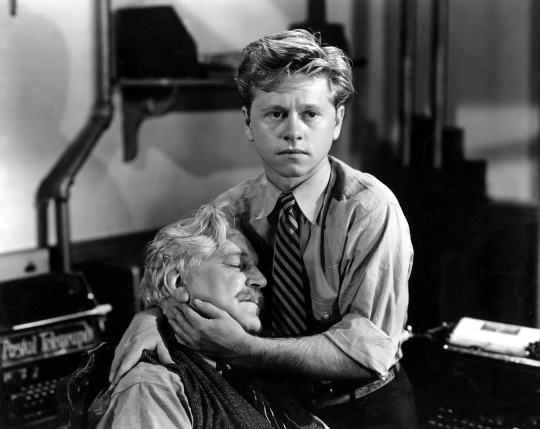
Mickey Rooney’s home studio wanted him to serve his country during World War II … but not in the way that you think. During World War II, Hollywood film studios helped express patriotic ideas through film. This could be through a film on soldiers experiencing military life, depicting Americana or Americans on the World War II homefront making sacrifices for those overseas.
As Metro-Goldwyn-Mayer’s top box-office draw, Rooney was cast in homespun comedies and musicals with wholesome values. Since 1937, Rooney starred in the Andy Hardy film series, where he played a teenager that figured out life, love and turned to his judge father for a “man-to-man talk” when he needed help. In total, there were 15 Andy Hardy films from 1937 to 1946 (and one later in 1958 with Andy Hardy as an adult) and they were hugely successful for the studio.
MGM felt that Rooney’s films, like Andy Hardy, personified American ideals and what servicemen and women were fighting for overseas. At least … that’s what MGM told the draft board.
With the war raging overseas, it was a real possibility that Rooney would be drafted, especially when other MGM contract players enlisted or were drafted. But studio heads wanted to keep Rooney out of the war and in front of film cameras, according to his biographers Richard A. Lertzman and William J. Birnes.

In 1942, Eddie Mannix, MGM executive and “fix it” man, sent formal documents to the local draft board to get Rooney an occupational deferment. Mannix cited the Andy Hardy films and their patriotism and that Rooney would soon begin production on another film important to the American homefront, THE HUMAN COMEDY (’43). Lertzman and Birnes noted that Mannix also stated the main reason MGM didn’t want Rooney in the military: the studio would lose millions.
The appeal was denied, but Rooney received an extension; allowing him to make THE HUMAN COMEDY. Based on a story by William Saroyan and directed by Clarence Brown, THE HUMAN COMEDY is a quiet story that follows an American family, the Macauley’s, during a year of adjustments in the small town of Ithaca. The film is narrated by Mr. Macauley, played by Ray Collins, who died two years prior. The eldest son Marcus (Van Johnson) is drafted. To help support the family, teenaged Homer (Rooney) gets an evening job in the local telegraph office. Homer’s family is rounded out by Ma (Fay Bainter), his sister Bess (Donna Reed) and his five-year-old brother Ulysses (Jackie “Butch” Jenkins).
As Homer gets more comfortable in his job, he matures and feels like everyone around him is changing — when it’s really just that he is growing up. As a telegraph delivery boy, he takes difficult messages to mothers who have lost their sons, and he has the responsibility of looking after alcoholic telegraph operator Willie Grogan, played by Frank Morgan. Everyone around Homer also changes and adapts. Bess and her friend Mary allow three soldiers on furlough to join them at the movies; knowing that soon they will see action on the battlefield. Homer’s boss Tom Spangler and socialite Diana Steed marry — bridging a social class gap and realizing that they are more similar than they think. Even Ulysses starts to learn more about life around him, like what it means to be afraid.

While the entire cast of notables play their roles superbly, Mickey Rooney is the standout performance in THE HUMAN COMEDY, and earned an Academy Award nomination for the role. In many of his other films, Rooney’s characters were variations of his Andy Hardy character. It didn’t matter if Rooney was portraying Huckleberry Finn or putting on a musical show with Judy Garland, shades of Hardy shine through.
But in THE HUMAN COMEDY, he plays the role in a restrained and mature manner. He’s emotional but doesn’t overact. It’s one of Rooney’s best performances. Perhaps because of a warning director Clarence Brown gave him: “The first time you shed an unnecessary tear or start any of the mugging you’re famous for, I’m going to halt everything, walk right out in the middle of the set, and give you a swift kick in the pants.”
Despite the early admonishing, Brown later said that Rooney was one of the greatest film talents and “could do no wrong in his book,” according to Brown’s biographer Gwenda Young. In one scene, Rooney had to emotionally read a telegram and react to the bad news. Brown was amazed that with each take, Rooney would “read it as though he’d seen it for the first time.” Brown and Rooney both later said that THE HUMAN COMEDY was one of the best films they made.

The film also features new talent such as Van Johnson, Donna Reed, Don DeFore, Barry Nelson and Robert Mitchum in his first film role.
Released in March 1943, the film garnered mixed reviews from critics, but ultimately was a success. Critics like Bosley Crowther of the New York Times said it was charming and had “moments of extraordinary beauty” but was also filled with “maudlin gobs of cinematic goo” when it came to some of the sermon-like dialogue. Critics overseas, who were closer to the battlefield, struggled with the message of “all men are angels,” according to Young.
As Rooney was filming THE HUMAN COMEDY, Mannix continued to submit appeals to the draft board from August 1942 to February 1943. Studio physician Dr. Edward Jones even stated that Rooney had a heart flutter, classifying him as 4F — unfit for duty, according to Lertzman and Birnes. Eventually, Rooney was able to serve his country more than in his film roles. Rooney was reclassified as 1A and he was enlisted in the Army in June 1944. Rooney later said he was proud of his service and continued to support veterans and attend World War II veteran ceremonies, including leading the Memorial Day Parade in Washington, D.C. in 2008.
#Mickey Rooney#Birthday#100th birthday#WWII#draft#Van Johnson#Donna Reed#Marsha Hunt#old hollywood#old movies#studio#MGM#TCM#Turner Classic Movies#Jessica Pickens
86 notes
·
View notes
Text
David Lynch & Surrealism: When the Non-Traditional Becomes Traditional

Often described as “one of the most unique visionaries working in cinema today,” it is not hard to see why director David Lynch and his unusual catalogue of work have garnered a lot of attention since the 80s (ScreenRant). Looking at his career holistically, it is evident how little his style has actually changed. Meanwhile, public perception of him and his productions has fluctuated quite a bit from decade to decade. After a somewhat uncertain start in the 1970s, he eventually rose to become arguably one of the most popular directors in the 21st century, which brought about strong implications for the world of independent cinema. The rise in popularity of David Lynch’s small but strong category of films brought about a wider acceptance of surrealist storytelling, as more audiences embraced the non-traditional storytelling so often associated with independent projects, further blurring the lines between industries and individuals.
David Lynch’s directorial debut, Eraserhead, actually serves as a perfect microcosm of his cinematic style and approach. First and foremost, it is utterly and proudly surreal. The entire film takes place in an ambiguous and unsettling interpretation of America – as many of his projects do – operating within a world that manages to both feel very familiar and very foreign at the same time. The film’s plot, focusing on a man and his grotesque, barely human child, is incredibly vague; Lynch keeps the purpose of the story open to interpretation, simply leaving the viewer with the shock and confusion at what they just watched. Eraserhead does not hold back: like many of Lynch’s films that follow it, it is gruesome, graphic, and sexual (ScreenRant). In other words, it had many of the characteristics that defined a number of flicks as independent cinema. Taking the risk of making such an off-putting movie did not come without its consequences, though.
Released to limited audiences in 1977, the film initially received a good amount of backlash. Variety denounced it as “unwatchable” due to the vagueness and brutality of its content, and since Lynch is notorious for refusing to give any clarification on most of his projects, interviewing him about the project provided no satisfying answers (Variety). It has since become something of a cult classic, embraced by fans of such dramatic and stupefying cinema (Chion 3). But it is easy to see why Lynch did not fit in with mainstream cinema at first. He made it clear that the kind of work he wanted to make did not have accessibility or comfort in mind. If Lynch wanted to be a surrealist director, it seemed he would have to accept that he would inevitably fail to capture the hearts of the average American viewers.
youtube
And yet, despite such a baffling first project, Lynch managed to break into Hollywood rather quickly. He found himself directing an adaptation of the science fiction novel Dune only seven years later in the mid-1980s. Much unlike his first work, Dune turned out to be very slow and boring. Its story is far more concrete, given it is drawing from a popular source text in a genre proven to have reliable appeal. The appeal did not transfer over, though; Dune was a commercial and critical flop (Hollywood Reporter). Lynch was not happy with it either; famously, there were a multitude of clashes and complications with the studio that led to the final release of the film differing greatly from his original four-hour vision. The disconnect is not only felt by Lynch, as Dune does stand out like a sore thumb amongst the rest of his filmography. It is considerably less obtuse and unusual than everything that came before and after, and yet still audiences refused to embrace it. The mainstream had rejected Lynch once again, who refused to be deterred.

Lynch stuck with his comfort zone and returned to writing and directing projects that outright ignored the mold in favor of the atypical (as independent filmmakers are known to do) (Nochimson 11). For instance, Blue Velvet was another clear example of Lynch’s untethered approach to storytelling, a late-80s suburban tale that was much more in line with his personal stylings than that of the mainstream movie circuit (Nerdist). Blue Velvet was a success, much more so than Dune or Eraserhead, but still did not become a Hollywood-level hit (Far Out Magazine). At this time, independent cinema had not quite reached the heights of popularity that it would soar to by the turn of the century. Audiences were not used to his level of surrealism…that is, until the arrival of a certain TV phenomenon. David Lynch’s first major foray into television was the mystery series Twin Peaks, premiering in 1990 on the ABC network. The opening episode was actually shot as a movie in case the show did not get picked up – and was even released as one outside of America with a more ‘concrete’ ending (well, concrete by Lynch’s standards). This premiere is arguably the most important work of David Lynch’s entire career, as it kickstarted what was his first project to really achieve true mainstream success. Its original run only lasted two years before a swift cancellation, but it made a huge impression on the audiences it did reach, especially after it took a hard turn into supernatural elements and had a massively ambiguous ending. Audiences were enthralled and intrigued after being hooked with the more mainstream premise of a teenage girl’s murder; Lynch had finally found a way to hook more viewers on to one of his non-standard projects (Nerdist). Thus, the attention achieved from the original finale of Twin Peaks (the only episodes he directed outside of the opening few of the first season) naturally had a very tangible impact on Lynch’s career.
youtube
After writing and directing another mind-bending independent film that came in the form of 1997’s Lost Highway, David Lynch signed on to direct the G-rated Disney romp The Straight Story (Filmmaker Magazine). This 1999 film is easily David Lynch’s most mainstream work. However, miniscule touches of his style are still prominent throughout the film. While it is the kind of saccharine story one would expect from Disney, it has a colorful cast of side characters (reminiscent of the residents of Twin Peaks) and its camerawork shares some broad similarities with Blue Velvet (Variety). All of this makes sense, given that The Straight Story was the first feature film that David Lynch directed while having no hand in the writing. Still, Lynch’s involvement in the project proved that Hollywood was finally recognizing his talents and seeking his unique style.
Ever since then, David Lynch has remained in the peripheral vision of mainstream audiences. While not quite a household name, his works have propelled him to being one of the more well-known American directors of the past half century or so. People retroactively began to look back on his older works and find renewed interest, turning Eraserhead and Blue Velvet into strong cult classics among film nerds alongside Twin Peaks. Concurrently, Lynch worked on a number of short films and shows across the 2000s, 2010s, and even into the 2020s. One of his most intriguing and baffling productions was a short, 60-second commercial he made for a Sony video game console, dubbed simply PlayStation 2: The Third Place. It is no more nonsensical than the rest of Lynch’s work, but it stands out because of its role as a promo for what would go on to be one of the best-selling video game consoles of all time. Even though it would be misguided to credit that all to Lynch’s advertisement, it nevertheless left a sizeable impact on a widespread audience, remaining in the memories of gaming communities for decades to come. In part thanks to the opportunity to reach wider audiences due to advancements made in the internet age, surrealist art was touching more people than ever and finding new audiences. Along with the rising popularity of independent film around the turn of the century, where non-traditional storytelling almost became its own miniature fad in Hollywood, David Lynch’s style was on its way to becoming mainstream.
youtube
What really cemented David Lynch in the hearts of cinephiles was his 2001 film Mulholland Drive. It felt like a perfect companion piece or spiritual successor to Twin Peaks with its interweaving plotlines, otherworldly side characters, and unclear lines of reality. The ending of Mulholland Drive is perhaps one of the most debated story moments of Lynch’s career because of just how surreal and non-linear it was. The film was quickly labeled one of the best films of the decade and has remained on many such lists in the following two decades (Nerdist). Since its release, Lynch has shifted his attention to television and other short-form content. He has continued to make surrealist short films like What Would Jack Do? that ended up on Netflix among other originals that became some of the most popular mainstream media of the decade. Meanwhile, he has used his YouTube channel to produce loads of short videos colored with his signature oddities, which consistently draw in thousands of viewers (Far Out Magazine). But the ultimate evidence of cultural power that Lynch managed to achieve – despite his rejection of mainstream filmic practices – was the story behind the Twin Peaks revival season that aired in 2017, known simply as The Return. A season that almost did not happen when executive and budget limitations stopped him from making the project, Showtime gave David Lynch completely free reign to make the 18-episode story he desired. It was slow, raw, abstract, uncomfortable – everything his works have come to be known for (Nerdist). And it was a massive success. Fans tuned in every week for to watch some of the most bizarre, dream-like television ever produced, proving that Showtime’s permission of creative liberties paid off.

Although Lynch may permanently shift mediums going forward, his surrealist style of storytelling will likely never dissipate. Not only is it essential to building the character of his works, it has become widely embraced across the nation as the appeal of his films (Creed 2). Lynchian surrealism brought him from the world of independent cinema to mainstream eyes, demonstrating how non-traditional storytelling has found popularity and widespread success with film audiences in recent years.
Want to learn more? My sources:
David Lynch by Michel Chion
The Passion of David Lynch: Wild at Heart in Hollywood by Martha P. Nochimson
The Untamed Eye and the Dark Side of Surrealism: Hitchcock, Lynch and Cronenberg by Barbara Creed
ScreenRant: https://screenrant.com/david-lynch-eraserhead-established-director-style/
Nerdist: https://nerdist.com/article/david-lynch-filmography-streaming/
Far Out Magazine: https://faroutmagazine.co.uk/david-lynch-career-eccentric-master-cinematic-surrealism/
Hollywood Reporter: https://www.hollywoodreporter.com/news/general-news/dune-review-1984-movie-953878/
Variety (1): https://variety.com/1999/film/reviews/the-straight-story-1117499811/
Variety (2): https://variety.com/1976/film/reviews/eraserhead-1200424018/
Filmmaker Magazine: https://filmmakermagazine.com/110889-theres-so-much-darkness-so-much-room-to-dream-david-lynch-on-lost-highway/#.YJK4JrVKiM9
4 notes
·
View notes
Text
The Taj Mahal of L.A. noir
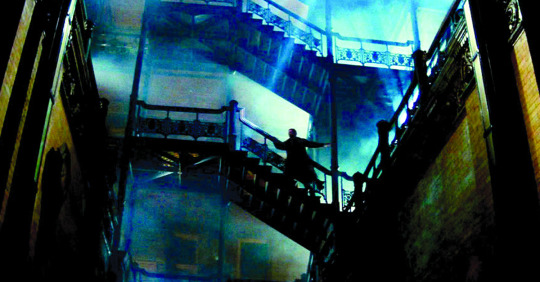
You may not live in Los Angeles, but if you’re a movie nut you’ve probably been inside the Bradbury Building dozens of times. Located downtown at the corner of Third and Broadway, the 123-year-old structure has been used in dozens of films, TV shows, and commercials – but most notably in some classic films noir and neo-noirs.
In 1892, the Bradbury was commissioned by its namesake, gold mining magnate Lewis L. Bradbury, who would not live to see its completion. Bradbury rejected a design by Sumner Hunt, but it was completed by one of the architect’s draftsmen, George Wyman. Hunt’s reluctant apprentice only took on the job after receiving approval from the spirit of his late brother, who was contacted via a planchette board, a precursor of the later Ouija board.
Opened in 1893, some months after Bradbury’s death, the edifice was one of the glories of its day. Inspired by Edward Bellamy’s futuristic utopian novel Looking Backward (19987), the five-story building sported a spacious atrium with a vast skylight, exposed brick walls, elegant tile floors, and spectacular iron work, employed on its angular staircases and parallel “birdcage” lobby elevators.
Naturally, as the local film industry developed, Hollywood came a-calling at the Bradbury. Some of its cinematic history is laid out in Thom Andersen’s sprawling, wonderful 2003 documentary Los Angeles Plays Itself, which surveys the way the capital of the movie industry has surveyed itself through its indigenous locations over the years.
The Bradbury made its movie debut in the 1943 wartime melodrama China Girl, standing in for a hotel in Burma. It would see a variety of uses thereafter, representing buildings in a plethora of locations, in genre pictures ranging from sci-fi (The Indestructible Man, a 1956 Lon Chaney, Jr. vehicle) to modern rom-com (2009’s The 500 Days of Summer) and even a latter-day silent feature (the 2011 Oscar winner The Artist).
But since the late ‘40s the building has been used most creatively and integrally in a variety of noir features, which have employed the setting – one that required little or no dressing or alteration to look dramatic and somewhat menacing – to great creative effect.
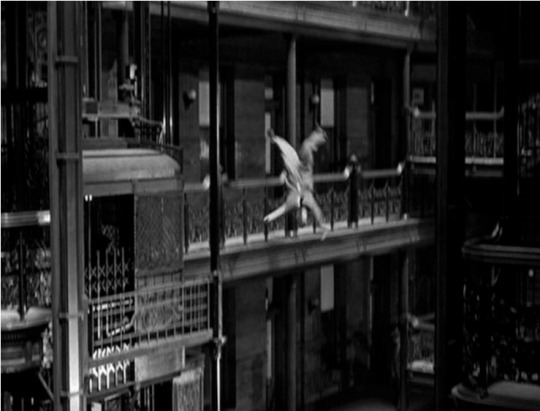
Its first appearance in noir was likely in Shockproof, a wacky 1949 picture set in Los Angeles. The picture was directed by Douglas Sirk, who would go on to greater renown in the ‘50s as the director of such highly perverse CinemaScope romantic dramas as Tarnished Angels, Written On the Wind, and All That Heaven Allows, all vehicles for Rock Hudson. It was scripted by Samuel Fuller, later the director of such noir-tinged pictures as The Crimson Kimono, Shock Corridor, and The Naked Kiss.
German émigré Sirk knew his expressionism, and he brought the style’s deep shadows to bear in his tale of parole officer Griff Marat (Cornel Wilde) and his new charge Jenny Marsh (Patricia Knight, Wilde’s real-life wife at the time), who become romantically and criminally entangled.
Marat and Marsh are introduced in a scene in which the newly paroled femme fatale visits the Bradbury Building parole office. The building’s atrium is later used effectively in a sequence in which two-time loser Joe Wilson (King Donovan) does a swan dive off one of the balconies to avert his return to prison.
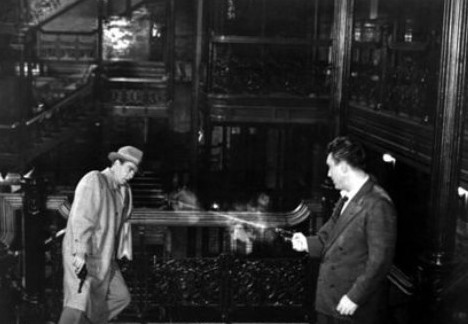
Another European refugee, Rudolf Maté, was already an old hand at noir, of the most exotic variety, by the time he directed the B classic D.O.A. in 1950 – as a cinematographer, he had worked on Charles Vidor’s Gilda and Orson Welles’ The Lady From Shanghai. He had also helmed the 1948 noir thriller The Dark Past.
As a director he is best remembered for his tense fourth feature, in which accountant Frank Bigelow (Edmond O’Brien) tracks the crooks who have dosed him with a slow-acting, lethal poison. Maté’s sharp location footage makes splendid use of the hallways and stairwells of the Bradbury Building in a climactic shootout, seen in this homemade “trailer.”
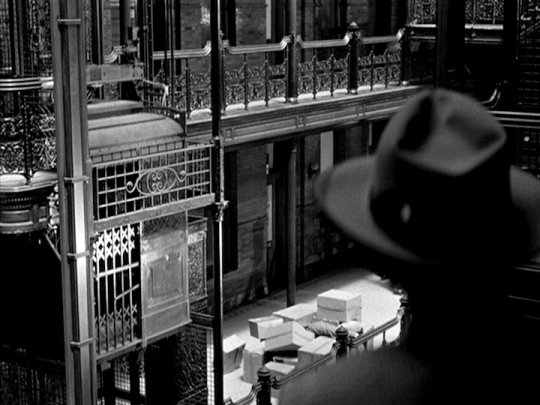
Possibly the most effective use of the Bradbury in classic noir came in M, Joseph Losey’s 1951 remake of Fritz Lang’s 1931 German feature. As in the original, the second version – little seen until its recent restoration – follows the hunt (relocated from an unnamed German city to L.A.) for a demented serial killer of children by the police and members of the local underworld, who are feeling the heat from the cops’ investigation.
David Wayne takes the role of murderer Martin Harrow, originated (under the moniker Hans Beckert) by Peter Lorre in Lang’s film. The highlight of the Losey edition arrives in a stellar chase through downtown L.A., during which the killer, pursued by mob thugs, takes refuge in the Bradbury (identified by its address in the script) with a terrified girl he has kidnapped.
Harrow finds himself trapped in the office of a mannequin maker as the hoods search the building room by room. (One has to wonder if Stanley Kubrick saw the film before using a similar setting in his New York-set 1955 noir Killer’s Kiss.) The sequence climaxes with a stellar shot, taken from one of the lobby lifts, in which the mobsters, led by boss Martin Gabel, soar to the Bradbury’s top floor in one of the elevators.
Fittingly, the Bradbury was used in Marlowe (1969), an adaptation of Raymond Chandler’s hardboiled, L.A.-set 1949 novel The Little Sister, as the office of private investigator Philip Marlowe, played by James “Rockford” Garner. The location plays hob with the original setting: Chandler scholars say that in the books, Marlowe’s digs were in the Taft Building at Hollywood and Vine, a visually less interesting Tinseltown site.
Marlowe is a little flat, and too bright to truly be considered noir, but its most entertaining scene (filmed on a set that stands in for a Bradbury office) marked the feature film debut of future kung fu star Bruce Lee. He portrays mob enforcer Winslow Wong, who pays a visit to Marlowe in an attempt to back him off an investigation.
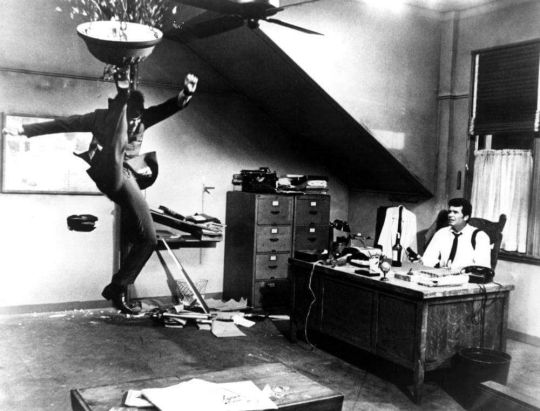
Carroll O’Connor, playing police lieutenant Christy French, can be seen in the actual hallway of the Bradbury as Lee makes his exit in the final shot. (Appropriately, in real life the Bradbury has housed the Los Angeles Police Department’s Internal Affairs Division since 1996.)
The Bradbury was pretty played out as a location by the time Ridley Scott began filming his sci-fi noir classic Blade Runner (1982), an adaptation of Philip K. Dick’s novella Do Androids Dream of Electric Sheep? The setting had become so familiar to moviegoers that screenwriter Hampton Fancher objected to its use, saying it had been done before. Scott replied, “It hasn’t been done the way I’m going to do it.”
And thus the Bradbury – swathed in smoke, swept by searchlights, sodden with rain water, with a spaceship advertising off-world living looming through its skylight -- stands in for the domicile of genetic engineer J.F. Sebastian (William Sanderson). It is there that “blade runner” Rick Deckard (Harrison Ford) has his showdown with the murderous fugitive replicant Roy Batty (Rutger Hauer) and his “pleasure unit” consort Pris (Daryl Hannah).
It’s unlikely that the Bradbury will ever be used as originally as Scott did in his spectacular movie. But as long as the building stands – and stand it will, since it was declared a national historic landmark in 1977 – it will certainly be visited again and again by film crews seeking a visual je ne sais quoi. Historically, that elegant antiquity can be considered L.A.’s Taj Mahal of darkness.

3 notes
·
View notes
Text
Thoughts : It (2017)
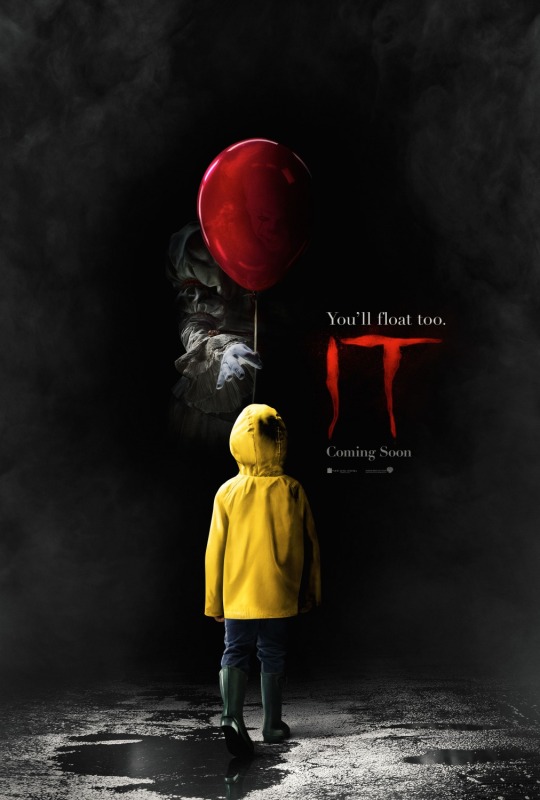
One of the most fascinating things about fandoms is the completely random nature they have in regards to the properties they choose to champion. I’m almost positive that when Stephen King initially wrote It, he never dreamed there would be not only multiple movies, but an extremely devoted fanbase and a general recognition of the collective fear of clowns held by the general public. Personally, I didn’t catch It-mania the first time around (even as a fan of Tim Curry), so when the recent remake hit the theaters, I felt no sense of urgency to see it. It was seeing the trailers for It Chapter Two, however, that finally piqued my interest and brought me to a viewing of the 2017 remake.
Bill Denbrough (Jaeden Lieberher) is home sick, but in a gesture of kindness, he makes a paper boat for his younger brother Georgie (Jackson Robert Scott) to play with in the rain. Georgie loses the boat in the gutter, and while peering in, he is scared, taunted and eventually assaulted by Pennywise (Bill Skargard), an ominous and terrifying clown. Bill is scarred by the event, but with the support of The Losers Club, his close knit group of friends, he plans to comb the sewers of Derry, Maine in hopes of uncovering the truth about his brother. The Losers Club, consisting of the brash Richie Tozier (Finn Wolfhard), mother’s boy Eddie Kaspbrak (Jack Dylan Glazer), and the pragmatic Stanley Uris (Wyatt Oleff), try to console Bill and keep his mind off of things, but Bill is unshaken in his quest for the truth. Meanwhile, tomboy Beverly Marsh (Sophia Lillis), in an attempt to find friendship amidst a nasty rumor campaign the town has adopted about her, befriends newcomer Ben Hanscom (Jeremy Ray Taylor), a shy bookworm that has taken it upon himself to study the turbulent history of Derry. All the while, Mike Hanlon ( Chosen Jacobs), a young black kid from the outskirts of town, is attempting to adapt to a life under the care of his hardworking grandfather in the wake of a housefire that killed his parents. All six children are tormented by the Bowers Gang, led by Henry Bowers (Nicholas Hamilton), the irrationally violent son of a Derry police officer. As the bond grows between the kids amidst the nightmarish attacks by Pennywise and the Bowers Gang, the newly expanded Losers Club must use all the tools at their disposal to defeat an enemy they do not understand, while nurturing a connection deeper than any they’ve ever known.
I really and truly do not know where to begin with this movie, and it is almost impossible to discuss this film without bringing up (if not making direct comparison to) the 1990 TV miniseries. I can flat out state that the 2017 film is an overall better film, and one that will more than likely escape the curse of looking dated decades down the road, save for astronomical leaps in technology. The most interesting thing about this movie, however, is the fact that it is not really a horror or suspense film, despite it having the shapings of one. No matter the nature of your enemy or villain in a horror film, there has to be a hint of reality in the mix to truly instill fear. Freddy may be over the top, but the damage he inflicts is tangible and visible to observers (we will circle back around to the Freddy thing momentarily). Jason instills fear because he never stops coming, and his attack is brutal when he catches you. Vampires, zombies, werewolves and even Frankenstein’s monster are rooted in historical lore. Pennywise, while being a fascinating villain, fails to land as a true terror due to a two-parted shortcoming : his outlandish nature makes him more of a cartoon character than a true threat, and as the kids state multiple times within the film, none of what he does is ‘real’ unless you fear him. It is intriguing how his power is, on the one hand, limited to perspective, but on the other hand, seemingly limitless due to the number of tricks he displays during the film.
For all the things that It does correctly, there is a series (and a villain) that does it better : Nightmare on Elm Street and the aforementioned Freddy. Rag tag group of high school misfits? Check. Ominous threat, based in the history of the city that it dwells in, that manifest mostly in the minds of its victims, though the repercussions of its actions are very much felt in the real world? Check. Heavy dose of the 1980s? Check. Equal doses of fear, controversy and humor? Check. That is not to say that It is not an entertaining and truly fascinating film, but with the burden of comparison to past versions of itself already on the table, it’s got enough of a mountain to climb to win over both those faithful to the creator of the property and those faithful to the original and iconic depiction of the titular character.
It may sound like I’m coming down rough on this film, but there are many things that it does quite well. For a film that displays the levels of violence that this one does, it does not necessarily glorify it or force you to dwell in it... even a broken arm is taken in as more of a realization than a focus, therefore making it easier to digest. The special effects are monumental, yet their visual integration is subtle and natural. For a film that is mostly carried by child and teenage actors, the acting is surprisingly strong across the board, even when the material is failed by forced exposition or finds itself in the realms of tropes. The sound design enhances the experience of the film, towing the line between building real suspense and reliance on jump scares with a finesse and restraint often not found in films of this nature. For a film where the villain/monster is so heavily present, Pennywise surprisingly does not wear out his welcome, remaining stunning and hard not to enjoy from the moment he pops up in the sewer until the moment he falls into the recesses of the well.
Jaeden Lieberher does a solid job as the sympathetic protagonist, finding a good range in regards to the use of his stutter, how believable he executes it, and the moments it goes away. Sophia Lillis steals the show with a confidence that bursts off the screen, and a killer smile to match. Jeremy Ray Taylor manages to dodge typecasting as the ‘fat kid’ as he proves himself to be one of the more valuable members of the Losers Club, while turning in a strong and endearing performance. Wyatt Oleff is forced to show a restraint not placed upon his costars as the groups’ voice of reason, but he does manage to bring dignity and logic to the crew, as well as a sense of rationale and reason in the midst of the mind-blowing. The joy that Finn Wolfhard is feeling in light of being given the green light to fully cut loose is impossible to ignore. Chosen Jacobs is not given much to work with, but similar to Oleff, he provides a grounding nature to the group. Jackson Robert Scott manages to somehow be one of the tougher members of the group while also leaning into his role as momma’s boy. Bill Skargard fully commits to making Pennywise as creepy, off-putting and uncanny valley reminding as he can. Nicholas Hamilton proves to be a serious threat, even as the secondary antagonist. Performances by Stephen Bogaert, Jake Sim, Owen Teague, Logan Thompson, Pip Dwyer and Stuart Hughes also stand out.
As popular as this film was, and as large a fanbase as it was able to garner, I imagine this will find life as a cult classic down the road. I’ve heard mixed reviews for It Chapter Two, and while I did enjoy my viewing of It, I don’t think I’ll rush to the theater for the follow-up. I will, however, be purchasing the two pack on Vudu when it drops, because I am certain I will revisit this film over the years.
#ChiefDoomsday#DOOMonFILM#StephenKing#AndyMuschietti#It#JaedenLieberher#WyattOleff#JeremyRayTaylor#SophiaLillis#FinnWolfhard#JackDylanGrazer#ChosenJacobs#NicholasHamilton#OwenTeague#JacksonRobertScott#StephenBogaert#BillSkarsgard#LoganThompson#JakeSim#StuartHughes#GeoffreyPounsett#PipDwyer#MollyJaneAtkinson#StevenWilliams#MeganCharpentier#JoeBostick#AriCohen#JavierBotet#TatumLee
7 notes
·
View notes
Text
You Have to Be Smart to Survive: Daveed Diggs and Rafael Casal on Blindspotting
During a press tour last month, Diggs and Casal spoke with RogerEbert.com about their meticulous approach to sound design, their seamlessly stylized dialogue and why having intelligent characters is a politically charged statement.
RC: The idea was to give every character their version of what was right in their mind. Early on, there are moments with Val where the audience is made to be pitted against her, and we make sure to eventually come around to her perspective, as well as the perspective of Miles’s girlfriend, Ashley. Even for Miles and Collin, it was necessary to have those moments. We liked the idea that it was messy and complex, because that is usually how perspective works.
DD: I am attracted to art that doesn’t present itself as an authority. As an artist presenting a piece of art, you have to be aware of your own blind spots. I think I am attracted to art where woven into the fabric of the thing is this fractured perspective, this idea that there are many ways to look at this thing that you are watching right now.
Your portrayal of the film’s inciting incident—the brawl outside the bar—is twofold: we first see it from a comedic angle, where the clueless white victim is dubbed “Portlandia,” and then from a tragic angle, as we hear the man echo Eric Garner’s cries of “I can’t breathe.”
DD: We do so much work early on to ensure that everyone can feel the world from Collin’s perspective, where we understand a lot of his reasoning for everything and for all of his choices. To present that moment in a way that is comedic allows you to really watch it without judging him initially. Then all of a sudden, you get to see the moment play out from Val’s perspective, in order for the audience to understand much more about her feelings, and also about the nature of this crime. If we’ve done our job right, this shift occurs without the audience realizing it. By the end of the film, you are rooting for a felon convicted of a violent crime, who maybe doesn’t get a lot of second glances in real life. We did a lot of work in the script to try and underscore Collin’s humanity and make sure that his entire self was represented. He is not only the crime that he committed, and even from one perspective, the crime is hilarious if you think about it.
RC: Our intention was to make the entire theater be on his side for most of that fight. Everyone in the room hates the hipster and thinks that Miles is being funny and the fire is entertaining. That flip on the perspective regarding the violence, depending on how we are encouraged to feel about it, matters. It shows how easily you can get swept up in a point of view if it favors your beliefs or is playing to your intuitive nature. We are giving you comedy, and so you are responding to the comedy, same as when you are watching the news. If the newscasters tell you that a person is a villain, you will treat them like a villain. The same trick that is happening in the film is what’s happening on the news every day.
I found the tonal shifts and lyrical dialogue in “Blindspotting” to be so much more seamless and assured than they were in a picture like Spike Lee’s “Chi-Raq.”
DD: We’re doing different things than Spike. “Chi-Raq” was an adaptation of a Classical Greek comedy, so the way he was attempting to use poetry was already forced. It was a forced situation that was meant to draw attention to the fact that the dialogue was poetry and not prose. We are doing the exact opposite. We’re trying to make you forget that you are listening to verse, but still have it function in the same way where it forces you to hear the important things and as a result, you sit forward a little bit in your chair. The writing is different, yes, but the biggest difference is in terms of performance. Carlos also played a big role in helping it feel natural when people are reciting verse but performing it as text. Rafael and I grew up doing that, so we’ve had a lot of practice. In many ways, the film is a reflection of how we grew up interacting with language. That is a big thing in the Bay Area, so we were really just trying to show off what we can do.
I particularly loved when Miles tells Val, “I am as moved by your greeting as you are moved by an elliptical.”
RC: It’s a joke that takes a couple seconds to register, and by the time it does, it’s more of an internal laugh. It’s a headier joke where you are like, “Oh, because an elliptical doesn’t move…” [laughs] But what I love about that line is it gives you a sense of the character’s vocabulary. One thing Daveed and I talked about a lot is how important it was for all of our characters to be really intelligent people. The Bay’s a very well-read place. A lot of the parents are very educated, whether traditionally or nontraditionally, and that savviness, that sophistication also coexists with the norm of city life and street culture. It doesn’t change it, it just gives it this nuance. That is a very heady joke for Miles to make and in any other movie, It would feel so strange for the street dudes to reference an elliptical as a joke in passing. Their intelligence has this broad stroke to it that allows you to watch them process things much faster, which also enables the verse. You know that they’re quick, witty and clever, but you don’t have a good sense of what their knowledge base is. You really just know a little bit about their behavioral flaws and not necessarily the limits of their intellect. For all we know, in every moment we don’t see him on camera, Collin sits around reading all day. There were versions of the script where that was the case. Miles and Ashley watch the news every night, and as younger people, that is not as common.
DD: I think it’s a politically left statement to not have stupid people in our work. We are existing in a world where there is this normalizing of ignorance, which is dangerous and actually untrue. That’s not how people are. I don’t know very many stupid people in my life, certainly not among disenfranchised people because it is hard to live that way. This normalizing of people being uninformed is dangerous because it presents it as okay, whereas that’s contrary to our survival mechanisms. You have to be smart to survive.
How involved were you both in the film’s extraordinarily visceral sound design?
RC: We were deeply involved from the beginning. All of those rhythmic musical refrains and elements to design Collin’s PTSD were originally in the script and decided on before we shot the film.
DD: We set the tempo months before we started shooting with members of my band Clipping. We did some rough passes on sound design elements, and though very little of that stuff got used, we recorded to them. When we performed the scenes, we had clicks in our ear. For the scene toward the end where Collin is in basement, I had that beeping sound in my ear to keep in line with the rhythm.
RC: I had a similar click in my ear during the dream sequence set in the courtroom. We knew super-super early on that both the score and the sound design were going to be essential in tracking Collin’s descent. We knew those PTSD moments were going to ramp up and climax in some of our final scenes, and that everything would have to get threaded back throughout the entire film, so we have alternating start points of when we learn about them, such as car horns or other sounds. We also had to make sure that the sounds were accurate in relation to where the characters were in Oakland, because we knew that people from the area would intuitively know if we had gotten something wrong.
DD: Getting to mix in Dolby Atmos was an extra sort of bonus after we received their grant. We worked with their artists while sitting on Michael Bay’s mixing stage and got to make adjustments like, “Can we throw that train noise back into the right because we know where this house is in relation to the actual train tracks in Oakland?” Coming from music, that was the sort of stuff that we were obsessed with. I am super-proud of the sound design in this film, and next time we do a movie, we’ll do more. We’ll actually start that process way earlier. I think there’s so much more we could’ve done.
RC: Even when we were doing our web series [“Hobbes and Me”], sound design was always our favorite part of the process. That is when everything on the screen comes to life, so when we got to sit in that room, that is where we, as filmmakers in post-production, really got to excel.
DD: That’s the coolest part to me. On my next film, I’m going to have composers onset the whole time.
5 notes
·
View notes
Text
Hiya, totally new to MBTI and all I am sure of is that I am probably some kind of intuitive person most likely either INTP, ENTP, ENFP, INFP or INTJ. Hoping you can help me narrow down stuff, and oh keep up the great work! I enjoy looking at my favourite fictional characters through your lens of MBTI typing.
Mod note: ENTP.
[Stuff I didn’t comment on removed for length]
Extrovert/Introvert My thoughts change pretty swiftly. I can go seamlessly from one topic to another, and come back to the old topic, occasionally draw connections between the topics on the spot which sometimes even I am surprised by. […] Oh man! I never stick to one decision, and even when I do it turns into like… a game of Chinese whispers where it starts out being one thing and towards the end, it has taken on a different form. With jobs, I do think frequently about quitting in favor of pursuing something way more interesting and fulfilling. I am a bit impractical in the sense that if I want out, I just go ahead and quit without really having a back-up job (even though I know it is good and ideal to do so, but just because it may be ideal to do so, I won’t wait around till it has happened. I can get really antsy when there is a brighter carrot being dangled in front of me and something is holding me back). A big motivator is definitely the promise of a bigger, brighter, something tomorrow. Even if its just vague outlines, it can get me pretty excited but also I can burn with excitement over an idea and if it doesn’t garner sufficient action and encouragement, I can get easily discouraged and drop it, feeling insecure of the merit of the idea or just drop it randomly, no reasons given. I just move on to the next thing, or sometimes I reflect on why that idea didn’t work […]My interests last anywhere between a few days or years, they are many and varied, I can get really caught up in them, investing in them even like this is going to be some lifelong thing. Turns out it is a phase, and I have had quite a few of these phases. Wanting to be an editor, dancer, taking up hospitality management full time, going into law enforcement, film-making, music, writing. The idea of change/recasting myself into a new role-new life is immensely exciting to me but often I find that I am underwhelmed when I do go after what I want. It is like the chase is more exciting, than doing the actual thing. […]I never tend to have singular visions of the future. I have multiple visions or plans that I keep working towards (or not, trusting that the image will keep changing and I will eventually end up adapting) I am okay with not working on all of them at once, as long as I know my chance isn’t shut off. My natural focus is directed towards mental stimulation and constant improvement of (quality and quantity of) interactions. I frequently abandon projects, often before I have even etched them out. I often have an image in my mind that I would like to draw but I have so fully etched it out in my head, and even end up envisioning the final product that by the time I actually take pencil to paper, I no longer want to do the thing. It just feels spent.
Ne-dom.
2. Thinking/Feeling I am far more stable with my relationships though I do tire of people easily. There are days when I don’t wish to talk to my best friend even, and I simply disappear without explanation, preferring to come back later and make sure we are good. It is important to me that we be okay though, because even after pulling something like that, I like to ensure there is some sense of harmony, I don’t like getting into conflict with friends and have never cut one out of my life so far.
Strong feeling function, but could be either Fi or Fe.
My personal understanding of my feelings is crap. I have had to work on it, and have gotten better at it. Usually I misread emotional cues in an environment, say something inappropriate and then kind of beat myself up (this is where my above mentioned social anxiety kicks in) over it till the other person tells me it wasn’t a big deal and that we are cool. I don’t know how they tend to drive me, honestly. Pretty bad at the emotional landscape. How they show up is in unexpected ways, it is like I never have a handle on the emotions especially under stress. It just kind of erupts. It is not that I bottle it up, think of it like a dormant volcano that’s been steadily spewing ash and stuff for sometime, and suddenly it just goes BOOM!
Bolded = likely tert-Fe.
Oh definitely, external validation matters more to me though I really wish I were confident enough from within to ignore those voices. [...] I am actually pretty articulate and wordy, so I have no trouble expressing how I feel, the way I solve emotional issues is by dissecting it with a friend and working my way through that emotional maze. I don’t always process immediately the intensity of the emotion that I am feeling which is what leads to the earlier dormant volcano kind of scenario because sometimes, even I am surprised by the depth of emotional impact Person/Event XYZ had on me. I realize this days/weeks/months later at times.
Fe.
Work example - When I run into a problem at work, my first instinct is always like that of Hermione Granger. “There must be an answer, I just need to look for it.” So, I then look at the client’s question and try to go beyond the mere wording, see what it actually means, what they want, what the scope of the thing is and I look at it in a lot of different ways. I go in deep while solving it, taking apart and examining for individual components while ensuring the solutions fits as a whole. I look at it in the context of the client’s work, their product and try to see their query as part of a bigger picture, an unsolved puzzle that I then put back together. Also, I am pretty efficient at jumping into their shoes and seeing what they might want and accordingly tweak my answers. I occasionally improv while presenting, and end up ambitiously biting off more than I can chew, which is especially hard for me considering my general poor time management/procrastination.
Ne/Ti.
3. Intuition based questions Vague terms usually, however sometimes I can get incredibly detailed if it is visual things but even then it is like I am describing a memory of it and not the actual thing. My way of looking at the world is like Portrait mode where everything else around can go out of focus, with an unerringly sharp zoom in on the object that I want to focus on.
Bolded = inferior Si / the rest, Si.
When I am in a new situation, I assess what I do know about the situation and how I can go from there. I certainly don’t jump into the situation and take control quickly. I look for cues in my environment to see what I should do next, keep switching gears to adapt, while often mentally reviewing if there was a similar situation ever earlier, or something I read about that could help me in the situation.
Ne/Si.
Inferior functions: Under stress, I comfort eat, I cling to certain things which I know will make me feel good, end up overdoing things or spiral into this dark place where I can never see any hope, or good possibilities ever again. I just keep feedback looping negatively to myself, and I find that I am unable to climb out of the hole dug by myself because of using negative confirmation bias from reliving past evidence of why I am right, why things won’t/can’t change etc.
Inferior Si grip.
Conclusion: ENTP
- ENFP Mod
26 notes
·
View notes
Text
How Hubris Undid the Dark Universe Movies
https://ift.tt/3gIijbX
The Dark Universe, Universal’s would-be monster movie franchise, may have only fallen apart a scant four years ago with 2017’s The Mummy, but the mindset behind its conception now (amidst the post-pandemic, theater-averse dominance of streaming,) feels like a notion from a completely different age. That logic, of course, implied that interminably lucrative, Marvel Cinematic Universe-like film franchises could be quickly conjured from just about any intellectual property. Interestingly, one of the writers involved, Eric Heisserer, believes the Dark Universe imploded behind the scenes well before it did at the box office.
Heisserer, who’s serving as showrunner for franchise-aspiring Netflix television adaptation Shadow and Bone, had just broken big with his Oscar-nominated screenplay for 2016 sci-fi drama Arrival and horror film Lights Out when he was tapped to co-write (with Jon Spaihts) a Dark Universe reboot movie for vampire hunter Van Helsing, which Channing Tatum was expected to headline. The gig put him in a dream team writer’s room convened by Universal to plan out a roadmap for the monster movies, which were to follow The Mummy with similar shared-universe renditions of the studio’s classic black-and-white adaptations like The Invisible Man (later revived in a scaled down Blumhouse-produced effort), Bride of Frankenstein, The Creature from the Black Lagoon, The Wolfman, Dr. Jekyll and Mr. Hyde, The Hunchback of Notre-Dame and The Phantom of the Opera. However, as Heisserer recently explained on The Playlist podcast, the unbridled enormity of the backlog made these plans untenable.
“To try and assume you are building something that is already pre-packaged as a cinematic universe, there’s a kind of hubris that I think audiences pick up on right away,” explains Heisserer. “They know you’re selling them a trailer to a bigger movie and assuming they’re going to show up. I don’t think that’s the right approach.” Indeed, Universal’s Dark Universe plans put the franchise cart before the proverbial plot horse, since the assumption that The Mummy—brandishing A-list headliner Tom Cruise, exorbitantly budgeted at $120 million—would launch a vast franchise from the outset interfered with the fundamental elements of atmosphere and storytelling. The flaw didn’t go unnoticed by contemporary audiences and critics, resulting in a paltry $80 million domestic gross, which, while boosted to a worldwide total of $409 million by a better overseas performance, fell significantly short of a $450 million break-even mark.
Universal Pictures
“It was a very strange experience,” says Heisserer of the rudderless status of the Dark Universe’s creative coalition. “There was certainly a big brain trust of writers around the table. You had a lot of voices and none of them could agree on much. Much like when I’d visit my relatives for Thanksgiving and everyone’s arguing with each other…You had some people saying, ‘Should our monsters all be villains in these movies or can they all be heroes?’” Thus, even with prominent producers Alex Kurtzman and Chris Morgan as heads of the table, and names like Noah Hawley, Aaron Guzikowski and Ed Solomon onboard, the Dark Universe writer’s room—akin to a bureaucracy—couldn’t even come to a basic consensus about whether each film’s eponymous monsters would be heroes or villains. Consequently, in September 2017, a mere three months after The Mummy’s disastrous run, Kurtzman and Morgan bowed out, and the once-auspicious dream team writer’s room would abruptly disband.
Yet, the ambivalence that sunk The Mummy—and, by proxy, the overall Dark Universe—is understandable, since the 2017 frenetic film franchise launcher attempted to have its cake and eat it by centering on Tom Cruise’s heroic protagonist, U.S. Army sergeant Nick Morton, who was pit opposite a villainess in Sofia Boutella’s undead bandage-wrapped witch, Ahmanet (a version of Boris Karloff’s classic Mummy, Imhotep). At the risk of dropping four-year-old spoilers, the film ended—of course, after Ahmanet’s defeat—with Cruise’s Nick becoming a kind of mummy after stabbing himself with magical trinket the Dagger of Set. Left endowed with the power to restore life, heroic quasi-mummy Nick properly resurrects his killed-and-zombified comic sidekick, Chris (Jake Johnson), setting up more cinematic adventures that could justifiably retain The Mummy branding. Yet, compounding confusion over the franchise focus, Russell Crowe’s Dr. Henry Jekyll (who even got to show off Mr. Hyde in a battle sequence,) was unsubtly positioned in the film as an expository Nick Fury-type figure, foreshadowing an Avengers-type crossover centered on a monster-hunting secret society called Prodigium.
Read more
Movies
Scarlett Johansson to Star as Bride of Frankenstein for A24
By David Crow
Movies
Dark Universe: The Undignified Death of a Cinematic Universe
By Ryan Lambie
Of course, none of that would come to fruition, and even the “Welcome to Prodigium” viral website that Universal had auspiciously set up to sow interest in the Dark Universe’s long-term plans now ignominiously calls up an unclaimed domain page. It’s a sorry state that resulted from a dysfunctional dynamic that became too common in the film industry, which typically gives in to impatience and a lack of understanding of the Marvel movie formula of starting small (like with 2008’s Iron Man) with compelling characters worthy enough for the audience’s continued investment before subtly teasing disciplined franchise plans. Heisserer poetically sums up the manic modus operandi of the Dark Universe writer’s room, explaining, “[S]omeone else would say, ‘We can build the plane when we fly it.’ And it’s me and Jon Spaihts at the table going, ‘That’s a terrible analogy. We don’t want to be on that plane. What are we doing here?’”
cnx.cmd.push(function() { cnx({ playerId: "106e33c0-3911-473c-b599-b1426db57530", }).render("0270c398a82f44f49c23c16122516796"); });
Having learned his lessons from the Dark Universe debacle—not to mention the apparent collapse of Columbia Pictures’ plans to spin off 2020 film Bloodshot (which he wrote,) into a Valiant Comics movie universe—Heisserer is currently focused on Shadow and Bone, which adapts the popular Grishaverse novels of author Leigh Bardugo. With the Netflix series garnering widespread acclaim, we can safely assume that this proverbial plane was safely built on terra firma. All eight episodes of Shadow and Bone‘s inaugural season can be binged on Netflix right now.
The post How Hubris Undid the Dark Universe Movies appeared first on Den of Geek.
from Den of Geek https://ift.tt/32QG6OQ
1 note
·
View note
Text
How to Properly Adapt Death Note in 105 Minutes
Alright, motherfuckers, I, like every other Death Note fan, watched one of my favorite franchises get shat all over for the sake of making a lame black comedy whose only goal seemed to be shitting on the source material because Adam Wingard comes off to me as thinking it’s stupid. A lot of people have been saying that “they only had 105 minutes” and “it’s an adaption so it couldn’t have been something that pleased fans”. I’ve written an outline for how to do a Death Note movie in 105 minutes that is accessible to American audiences while pleasing fans. It sets up for a sequel, yeah, but I think Death Note’s record of success when done right means that’s not much of a risk. The goal here is to prove that even when not allowed the thirteen-hour-long episode season of a Netflix series it deserves that the material can still be dynamically entertaining because it’s just that strong. I also set out to prove that if a 21-year-old hick with no professional experience in writing can write something that functions well enough to appease both the fans I know and have shared this with and people who don’t know the material (like my middle-aged father!) then there is no reason that professionals hired by Netflix couldn’t do the same. Read my outline below the cut.
Setting:
New York City makes the most sense as a parallel to Tokyo since it is just as heavily associated with its native country outside of said country. It also allows for a rich backdrop for the movie to pull from both in terms of casting and in terms of scenery. Characters:
Light Yagami- As the surname implies, Light and his family are all Japanese-Americans played by Japanese-American actors. Light is one of the top students in the country, and the top law student at his university. He is charismatic and suave. He dresses sharp, and keeps a room that is neat but not obsessively so. He is conniving and cocky. He is obsessed with purifying the world, and will do anything it takes to accomplish this goal. He explains his complex plans to Ryuk so we, the audience, can keep up.
Sorichiro Yagami- Hardworking and dedicated, Sorichiro is one of the finest among New York’s finest. He is a believer in the justice system despite its faults. A great police captain, he is an even better father and husband. He’s the reason for Light’s being a law-student and his sense of justice.
Ryuk- The only character not in need of recasting or redesigning from the Wingard film, most of Ryuk’s alterations are characterization-based. Ryuk has an easy-come-easy-go attitude towards the events of the film. He has no investment in either Light’s success or failure as would be expected from the sort that drops a Death Note for just any human to find. Snarky, creepy, and adorable in a bulldog sort of way, Ryuk is Light’s companion for most of the film.
Misa Amane- Barely factoring into the film, Misa is a musician with a goth-lolita aesthetic who rocketed to success after starting out on YouTube as MisaMisa. Her only appearance in the film is a scene where Ryuk is watching a talk-show. She is also to be played by an Japanese-American actor.
L- The world’s greatest detective and the Holmes to Light’s Moriarty, L needs to be as interesting to the audience as Kira himself. L’s sense of justice is the cause his insomnia because it drives him to always be working cases under one alias or another. A believer in the human capacity for change, L is disturbed by Kira and his popularity, but he is also excited to encounter an opponent that’s his intellectual equal. A person with Asperger’s, L has a preference for looser clothing, hatred of socks and any similarly rough fabrics, and particular ways of sitting and holding things. He has a great fondness for any and all sweets. L’s actor needs to be an unknown with the ability to be unconventionally attractive similar to the likes of Johnny Depp or Jared Leto. His actor should be British, and should be shown some of Juliani and Stanfield’s performances in order to get a handle on the character’s way of speaking. I would like for his actor to be white since L’s design from the manga and anime is one of my favorite in fiction, but I’d have no problem casting someone of another ethnicity if their performance during an audition felt like the right fit for the role to me.
Watari- An old inventor and ex-British military sniper, Watari, like Alfred Pennyworth, is an English gentlemen’s gentlemen. His being L’s financial support and public representative makes sense seeing as he’s the one responsible for raising the eccentric detective. This doesn’t need to be explicitly stated in the film, but instead shown through small, tender moments like Watari fetching L a blanket or sweet he didn’t ask for. His real name is Quillish Wammy, though that wouldn’t be revealed in this film, and race is unimportant in the casting of his character.
The Kira Investigation Task Force- The men who stuck around following the deaths of the 50 F.B.I. agents, the Task Force are all brave souls dedicated to the arrest of Kira. Mostly serving as an everyman’s way into L’s methods and an excuse for L to explain his plans to the audience, the characterization here doesn’t have to be too strong save for Matsuda and Aizawa. *Matsuda is a rookie detective whose age allows for him to have the most open mind when it comes to Kira. He still wants Kira caught, but he sees why so many support the killer.
*Aizawa is the most skeptical about working with L. He feels the detective has a way of using people that comes from a mindset too similar to Kira’s for his liking.
The Task Force should be casted as multiracial to take advantage of NYC’s melting-pot population and give representation. They receive their original names from the manga as aliases from L upon meeting him in person as a safety precaution.
Raye Penber- The F.B.I. agent charged with pursuing Light Yagami and fiancé to Naomi Misora, Raye is a man who opposes Kira as deeply as he loves his bride-to-be. He needs to have a good chemistry with Naomi so that the audience feels his death’s impact after only a scene or two with them together. He needs to be attractive in a James Bond sort of way. His actor should be Japanese-American, and someone who is unopposed to returning for a possible prequel adapting events of Death Note: Another Note: The Los Angeles B.B. Murder Cases.
Naomi Misora- Equal parts loving fiancé and cunning ex-F.B.I. agent, Naomi Misora is Light’s greatest threat after L. Having resigned from the F.B.I. in hopes of pursuing a career in writing and as wife and mother, Naomi is devastated by the loss of her husband. Her pursuit of Light Yagami is fueled by her hatred for Kira’s ideology and revenge for Raye, and is ultimately what gets her killed. Her death should subtly upset L to hint at one-sided feelings for the doomed woman picked up during the briefly alluded to L.A. B.B. Murder Cases. She should be played by a Japanese-American actor who isn’t opposed to possibly returning for a prequel adapting those events down the line.
Plot:
The skeleton for the plot here is the first Japanese live-action film.
The film opens with Light Yagami , a second-year law student who feels aimless in his path to become a part of a system he sees flaws in, bored in his seat-by-the-window during one of his classes. These feelings would usually either lead to a career of cynicism or of bucking said system, but things take an unusual turn when Light sees a notebook drop out of the sky during one of his classes. After class, he picks up the notebook, called “Death Note”, and finds a list of rules written inside of the front cover.
1. The Human Whose Name is Written in This Notebook Shall Die.
2. If a Cause of Death is Not Written Within 40 Seconds of Writing a Name, The Human Will Simply Die of a Heart Attack.
3. After Writing the Cause of Death, Six Minutes are Allotted to Provide Details for Circumstances Surrounding The Death.
He assumes the notebook to be a morbid prank.
The next scene has Light discover the authenticity of its powers after writing down the name of a man holding a gas station hostage after seeing live news coverage of the event on the TV in his room. Initially horrified, Light decides to use the Death Note to clean up the world after a court case that gave a rapist a three-year prison sentence is discussed in one of his classes the next day.
The next scene is set a few days after this with Light returning home to his room to find what is apparently a demon waiting for him. The demon explains it is actually a bored god of death, or Shinigami, named Ryuk who dropped the Death Note, what is used by Shinigami to fulfill their job of killing humans, in the human world so “something interesting” would happen. He spends the rest of the film eating apples and cracking wise. Light learns only people who have touched the Death Note can see Ryuk after his sister comes in his room wanting help with her math homework.
Through a montage, we see that Light’s killing of criminals, initially only local and then international, soon garners him a following on the internet in places like Facebook, Tumblr, Reddit, and 4Chan. The name Kira, based on saying “Killer” with a Japanese accent, catches on as the way his supporters refer to him online. The media calls the killings “ a strange series of heart attacks”.
The next scene shows NYPD Captain Sorichiro being called to the Commissioner’s office, and finding a well-dressed old, British man called “Watari” waiting for him alongside the commissioner. Watari explains that he represents “L”, the world’s greatest detective. The police commissioner explains that Watari is the public’s only direct line to L. Watari then pulls a laptop from his briefcase, and opens it to reveal a white screen with a black Old English style “L” in the center. A voice put through several digital filters greets the men in the room, and declares itself to be L. L tells the men of Interpol’s debate over the cause of so many criminal deaths, and that he suspects the deaths to be murders. His reasoning is that criminals being so specifically targeted makes a disease unlikely. He suspects these murders to be perpetrated by a single killer somehow since the range of the killings would take a number of people working together that would make success as unlikely as a disease. He accompanies his reasoning with charts displaying information backing him up displayed on the laptop screen. L says that he would like to work with the NYPD to assemble a 50-man task force with Sorichiro at its head because he suspects Kira may be operating out of New York City since that’s where the initial killings were located.
Next up is a scene of Light’s family greeting Light’s father, who is revealed to be Sorichiro, after he’s gotten home from work. He mentions the NYPD doing something about Kira after Light’s sister mentions her classmates talking about the killer at school. Ryuk laughs over Light’s Dad unknowingly being after him.
We then get a scene of the Task Force’s HQ being set up. L speaks to the men, again through a laptop Watari brings, commenting on their bravery and how he will be releasing a public statement against Kira.
We cut to Light watching TV in his room only for the broadcast to be interrupted by what is called a worldwide broadcast. A man named Lind L. Taylor appears on screen, and declares himself to be L. He speaks out against Kira, calling him evil and childish, and claiming he will single handedly apprehend the criminal. Light, feeling insulted by this, writes Taylor’s name in the Death Note. After Taylor dies of a heart attack, Light gloats to Ryuk, but is interrupted when the broadcast cuts to the “L screen” previously seen on the Watari’s laptop. L’s synthesized voice expresses astonishment at how well his plan worked. He addresses Kira directly as he explains that the man named Lind L. Taylor was an inmate on death row set to be executed that night who had agreed to pretend to be L in exchange for being pardoned in the event that Kira didn’t kill him during his TV appearance. L adds that the broadcast wasn’t actually a worldwide broadcast but limited to New York City. Had Taylor lived, the plan would have been implemented in different areas using different inmates. L knows Kira’s location, and that a name and face are needed for him to kill. He dares Kira to kill him without having either on the detective. Ryuk thinks this all hilarious, and Light is furious. L declares that he is justice, and the broadcast ends.
A montage of television programs discussing L’s TV appearance plays, ending with singer Misa Amane expressing her support for Kira. It’s shown that it’s Ryuk that’s been looking at these TV shows, and he turns to tell Light how badly he’s been shown up. Light tells Ryuk he’s already going to get back at L. Using his father’s username and password, Light looks at inmates convicted in cases involving rape, murder, or child molestation, and uses the Death Note to make them all write suicide notes on the walls of their cells using their own blood before committing suicide in differently specific ways that test the limitations of the Death Note.
We next have a scene of the Task Force discussing the deaths, and realizing that there is a message to L hidden in the first letter of each sentence in the notes that can only be seen when they are examined together. The message is, “L, did you know that gods of death love apples?” L says that the message isn’t the real point of these deaths, but it was to show that Kira can control people’s actions before they die.
The next scene is of Light and Ryuk walking through a park. Light’s wearing a Bluetooth headset so that he doesn’t look like a crazy person while talking to Ryuk. Ryuk tells Light that someone is following him, and is only telling him because it makes the Shinigami feel like he’s the one being watched. Ryuk says it’s been three days since this began when Light asks him.
Next is L telling the Task Force that he has F.B.I. agents tailing members of each of their families. When they express outrage, L explains that Kira has to have a connection not only to law enforcement in general but specifically the Task Force to know to access the database the NYPD keeps on inmates in relatively local prisons since no one outside of L, Watari, the commissioner, and actual members of the Task Force know that L is working with the NYPD. This quiets the discontent some, and it is totally killed when Captain Yagami expresses his support of L’s plan.
Next we have Light in his room writing names in the Death Note when Ryuk tells him that there is a simple way to figure out the name of his stalker. He explains all Shinigami have eyes capable of seeing the names and lifespans of all humans they see in order to do their job of writing names in their Death Notes, and that Light can be given this sight with no change in the appearance of his eyes in exchange for half of his remaining years of life. Light declines this offer, and tells Ryuk he already has a plan.
We then have a scene of the man tailing Light returning home to his fiancé, a woman named Naomi Misora. She’s working on a novel about a young man searching for his missing friend from college. He says he’ll be able to focus on their wedding again soon as he’ll be done with tailing the families he’s been assigned to follow Friday. Naomi asks if he thinks that any of them could be Kira, and he tells her no. He adds that she would be the better out of the two of them to ask since she was good enough to work with L when she was in the F.B.I. She dismisses him by saying she’d rather focus on writing and loving him than Kira.
Next we have Light getting on a bus to the zoo with his stalker close behind. Light spends the first few seconds of the ride with his headphones in and watching a video on his phone. This is all interrupted, though, when a man with a gun takes the bus hostage. He uses the driver’s radio to demand $10,000 from the zoo. Light looks to the seats behind him to see his stalker sitting in the seat directly behind his. Light asks him if he wants to do something about the hijacker, and the man agrees. Before they do anything, though, Light wants proof that the man isn’t working with the hijacker. After a moment’s hesitation, the man shows an F.B.I. badge revealing his name to be “Raye Penber”. Satisfied, Light says he’ll pass him a note since the hijacker’s about to turn his attention back to the passengers. Light drops the paper as he’s passing it, and the hijacker notices. After reading the paper, he points his gun at Light’s face, and asks him if he’s “Some kind of hero?!”. Before he can kill Light, though, he notices Ryuk standing in the aisle of the bus. Ryuk expresses surprise and laughs when he realizes that the paper must’ve been torn from a page in the Death Note. Panicking, the hijacker shoots at Ryuk, the bullets just passing through to break the rear window, and demands the driver stop the bus. He runs out of the bus only to be hit by a car. After the police let Light leave the scene, Ryuk asks him if the hijacker was a criminal Light wrote would do all of that in the Death Note to which Light answers yes. He adds that the incident would have always ended in his favor since he would have at least seemed “too noble” to be Kira had Penber provided some other means of proving he wasn’t working with the hijacker, but the name will allow for Light to send a message.
Next is a scene of Raye telling Naomi over breakfast that he won’t be able to go with her to meet with the priest like they’d planned . Naomi, confused, asks Raye why, but he tells her he can’t say.
Next is Raye going down to a subway to catch a 1:00 PM train heading to some arbitrary location. He is approached from behind from a disguised, hoodie-wearing-Light, who tells him that he is Kira, and that he will kill everyone around them unless he complies to his demands. Light speaks in harsh whisper to mask his voice somewhat. Raye complies, and takes the seat next to the door of the train at Light’s instruction. He takes a manila envelope containing a cheap cellphone, sheet of paper, and a pen from the luggage rack also at Light instruction. The phone rings, and Light is on the other end of the line. He tells Penber to write the names of his fellow F.B.I. agents current tailing anyone in relation to the Kira Investigation. Raye says he doesn’t know the names. He asks for Raye’s superior that is heading the team of agents, and Penber gives it to him. A few moments later, Raye receives a phone call from his superior, and is told the names of his fellow agents. Light again tells him to write down the names, and Raye does so this time. Raye is told to put the cellphone, pen, and paper back in the envelope before placing it back on the luggage rack, and that he is to get off at the train’s next stop. As all of this occurs, a narration from Light begins. “Raye Penber. Heart attack. He cancels any and all plans he has, and tells no one why. He heads to the subway for the 1:00 PM train heading for ((Insert Arbitrary Location Here)). There, he encounters the man known as Kira, and complies with the man’s demands. He gets off at the stop that comes after his compliance, and dies.” Towards the end of the narration, Raye gets off the train, turns to find a smiling-and-envelope-holding Light standing behind the now closed train doors, and die, shocked, reaching towards his killer as the train departs.
Next is Light and Ryuk exiting the subway, and entering a dirty alleyway. Light pulls out a bottle of some flammable liquid from his hoodie pocket, pours the liquid all over the envelope, and drops a match. He adds the bottle into the resulting fire, and smiles knowingly at Ryuk.
We cut to Captain Yagami informing the Task Force that all 50 of the F.B.I. agents tailing their families and the man supervising the agents have died of heart attacks. He says that, in light of this, any who wish to exit the investigation are free to do so without consequence. All but six men take this offer. Captain Yagami tells L that there are only seven of them left. L expresses disappointment while complimenting the bravery of the seven. One of the men (Aizawa) rebukes this compliment by insulting L for hiding himself from the world and keeping them at an arm’s length. L takes this to heart, and tells the men to meet him at a specific hotel in two days. The same man who rebuked L’s compliment asks why they have to do this, and Watari tells him that they are going to be meeting L.
Our next scene is of Raye Penber’s funeral with a vengeful Naomi watching her fiancé’s casket be lowered into the ground.
We then cut to the Task Force arriving in the lobby of the designated hotel to find Watari waiting for them. The old man leads them to the room where L is staying. After they enter, a man about Light’s age with pale skin, messy black hair, a white long-sleeve shirt, and baggy blue jeans comes out, and reveals himself to be L after greeting them. Each member of the Task Force gives their name in return, and L tells them that they would all be dead if he were Kira. He gives each member their corresponding manga name as an alias, and asks for them to refer to him as “Ryuzaki” from now on. He gives them a pep talk that assures them that justice will prevail in the end.
Next we cut to Naomi talking to the driver of the hijacked bus during his lunchbreak. She asks him if he saw Raye talking to anyone after showing him a picture of her fiancé. He says he saw him talking to a young guy who didn’t even flinch when the hijacker pointed a gun in his face.
We cut to Watari placing a blanket on L, who has fallen asleep in his crouching/sitting position only for the detective to be awoken by the ringing of his personal cellphone. Naomi is the one calling him, and he expresses quiet surprise after finding this out. She tells him she suspects that Light is Kira because of Raye’s death after revealing his name to him, and that she’ll be proven right if she’s found dead soon. L says he won’t be able to use her claims as proof in a court case since his personal cellphone is the only one he has that isn’t bugged. She says she knows this, but that she also knows he’ll find something that can be used in court now that he has this information. Naomi ends the phone call with a “goodbye”.
The next scene begins with L telling the Task Force he wants to bug Captain Yagami and the Commissioner’s houses. They’re understandably upset, but L explains by showing footage of Raye Penber’s death as captured by security cameras. He says his shock before dying means he recognized a person on the train, and his reaching even as he dies suggests that person was Kira. Raye was tailing members of the two families so Kira must have been among them, and killed Raye for getting too close with the deaths of the other agents being a means of covering themselves and an intimidation tactic. Sorichiro agrees to the bugging of his house under the condition that he and L be the ones to watch the feed with the others watching the commissioner’s. L accepts this condition, and says the observation will only last for two weeks.
We next have Light returning home to his room. Ryuk suggests that they play video games now that the human has come home, but Light acts as if the Shinigami isn’t there. We see L and Sorichiro watching all this and everything else in the house on various screens. After putting his school things away, Light leaves the house. He now tells Ryuk that he suspects his room has been bugged, and can’t speak to him in his house until they’re gone. When asked how he could know such a thing, Light says he’s been putting a pencil lead above the top hinge of his bedroom door as a means of preserving his privacy while away from home since he was a teenager because the lead always breaks when the door is opened. Ryuk is distressed by his apple supply being cut off, and Light is frustrated over not knowing how L could even suspect him. Ryuk asks Light just what it is he’s going to do about it, and Light smiles after a moment’s consideration.
We cut to L and a clearly haggard Captain Yagami watching the Captain’s family eat dinner. L expresses admiration for Sorichiro’s dedication to his family. Sorichiro asks why Light’s room has the most cameras, and L says Light’s intellect makes him the most likely to be Kira. On the camera feed, Light says he’s going to his room to do homework. He grabs a previously opened bag of chips, and heads for his room. He starts doing his homework, eating chips every few minutes. Downstairs, the local news reports on the apprehension of a man who’d robbed a grocery store, killing three people in the process. The man suddenly dies of a heart attack. Light’s shown no change in behavior that would allow for him to see this report. Throughout all of this it should cut between the feed and L and Sorichiro watching it. The Task Force celebrates Light and the rest of Sorichiro’s family being relieved of suspicion, and L is frustrated.
We cut to reveal Light had a piece of the Death Note, another pen, and a smartphone hidden in the bag of chips.
The next scene is Light leaving school, and none other than Naomi Misora meeting him on the way to his car. She answers his confusion by telling him her name, and that she knows he is Kira. Light calls her crazy, trying to get past her, but Misora won’t let him pass. She tells him that Raye Penber was her fiancé, and that she’ll see him exposed to avenge Raye. Light pushes past her, and drives off.
We cut to Light getting home to his room. Ryuk excitedly tells him all the cameras are gone, and Light tosses him an apple he’d been keeping in his desk drawer.
Our next scene has the Task Force arriving to L’s hotel room. L asks Captain Yagami if he’s enjoyed going home to which the Captain says yes. L begins to tell them what he thinks their next plan of action should be, but he is interrupted by his cellphone ringing. He answers to find Naomi once again waiting for him on the other end. She tells him she’s sending him a link to a video feed so that he can watch Kira confess to his crimes. L asks her just what she’s planning to do, and she tells him she’s already done what she planned to do before ending the call. L tells Watari to go to the linked feed. The feed shows Light tied to a chair, and alone in a dark room. He seems confused and scared, calling for someone to explain what’s going on. Sorichiro is horrified, and asks L what’s going on in an accusatory tone. L tells Watari to begin tracing the feed, and gives the Task Force a summation of what’s going on. They all watch as Naomi enters the dark room, apparently a warehouse given the door type. She says she knows Light is Kira, and he’s going to have to either confess or kill her like he killed Raye before she can kill him if he wants to live. Light denies her accusation, and begs to be let go. This deeply disturbs the Task Force. Naomi begins to torture Light in an attempt to get a confession. Tension builds as we wait for Watari to find the location. He finds that the feed is coming from a warehouse called “The Yellow Box” which was used as a location for mob negotiations in decades past. Sorichiro and the Task Force immediately head out.
We cut between their racing towards The Yellow Box and Naomi’s torturing Light.
Naomi pulls out a gun, aiming it at the bleeding and crying Light, saying that she is going to kill him in ten seconds if doesn’t confess or kill her first. Before she can shoot him, though, Sorichiro and the Task Force arrive, telling Naomi to drop her weapon and put her hands above her head. Naomi, apparently realizing she’s gone too far, asks Raye to forgive her and shoots herself in the head. Sorichiro unties Light, embracing him and crying over his relief for his son’s safety. He and the other Task Force members walk him out of the warehouse so that he can receive proper medical attention. Over this tender scene, Light narrates,“ Naomi Misora. Suicide. After abducting the person responsible for her fiancé’s death, she contacts those responsible for the Kira Investigation, and provides them with a way of watching as she tortures her captive in order to get him to confess to being the killer known as Kira. She threatens to kill her captive, but, upon the intervention of the police, realizes how far she’s taken her search for answers, and ends her life with a gunshot to the head.”
Our final scene starts with Light in his room, now bandaged in the areas where he was most severely injured during his interrogation. The doorbell rings, and he goes to the door to answer it. He opens the door to find L on his doorstep. The detective reveals his identity to Light, and asks to speak with Light inside. L explains to him that he wants Light to join the Task Force. He adds that he suspects Light to be Kira. He talks of how Naomi had called him before Light’s abduction, and how she’d said Light must be Kira if she were to die soon. He adds how uncharacteristically irrational she was in her final actions, and how they know Kira has the ability to control the actions of his victims before their deaths. Light counters this by saying that her fiancé’s death must have sent her over the edge, and that he would’ve just killed Naomi while she was torturing if he actually were Kira since he knew her name and face. Light then asks why L would want him on the Task Force if he suspects that Light is Kira. L lies that Light’s odds of being Kira are only 5%, and, that if he is wrong about Light being Kira, Light’s track record of successfully assisting the police in previous cases would make him a great asset in finding and arresting the real Kira. Light fakes consideration, and accepts L’s offer by shaking the detective’s hand. The film closes with Ryuk laughing and saying, “Humans are so interesting!”
#deathnote#Death Note#light yagami#L#l lawliet#Ryuk#Shinigami#Apple#Apples#Sorichiro Yagami#Kira#Kira Investigation Task Force#Matsuda#Aizawa#misa amane#Misamisa#Misa misa#naomi misora#raye penber#Watari#quillish wammy#manga#anime#netflix#2017#adam wingard#light turner#nat wolff#lakeith stanfield#william dafoe
163 notes
·
View notes
Text
The Weekend Warrior January 31, 2020 – THE TRAITOR, THE RHYTHM SECTION, GRETEL AND HANSEL, OSCAR-NOMINATED SHORTS
Last week was fairly pitiful, relly, but that doesn’t mean this weekend is gonna be much better. At least Guy Ritchie’s The Gentlemen exceeded my original expectations despite its fairly moderate theater count, and Universal’s The Turning is the studio’s latest horror film to bomb as 1917 continues to do well-deserved big business, crossing the $100 million mark. Actually, most of the movies this past weekend got a nice bump on Saturday, possibly due to the crappy weather across the country. This weekend won’t be so lucky.
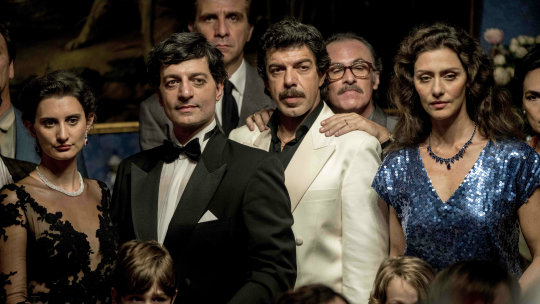
Before I get to the wide releases, only one of which I’ll have seen by the time you read this, I want to instead draw attention to one of this week’s limited releases. Marco Bellochio’s THE TRAITOR (Sony Pictures Classics) was Italy’s selection for the Oscars and deservedly so, but it wasn’t even shortlisted in the new “International Film” category, which is a real shame. It stars Pierfrancesco Favino as Tomassso Buscetta, part of the notorious Palermo-based Casa Nostra crime family, responsible for much of the heroin trade in the early ‘80s. After Buscetta flees to Brazil with his wife (Maria Fernanda Candido) and large family in 1981, he’s eventually arrested by the Brazilian authorities and deported back to Palermo where he turns informer and works with Judge Giovanni Falcone (Fausto Alessi) to try to take out the Sicilian mob family.
I can’t even begin to tell you how amazing this film is, even if you go in cynically believing you already know everything about the so-called “MAFIA” from watching Goodfellas or “The Godfather” movies. You can tell that Bellochio really did his research into the life of Buscetta, and then had the wise move of hiring Favino (who I met on the set of Disney’s Prince Caspian, of all things!). Favino embodies Buscetta in a way similar to Edgar Rodriguez in Olivier Assayas’ Carlos, as the film covers almost three decades of his life, much of it in paranoia for turning on his criminal brothers.
The movie has a few lulls, most notably during the lengthy courtroom/trial scenes that are unlike anything you’ll ever have seen before or after – they’re complete madhouses – but the movie also delivers in quieter dialogue scenes, particularly those between Favino and Alesi. It’s amazing to think that someone responsible for so many deaths, both by his own hand and by heroin addiction, could be turned into a bonafide hero, but it’s hard to deny how brave Buscetta must have been for being involved with the takedown of the Casa Nostra for over a decade.
Bellachio has made a film that’s on par and sometimes even better than Scorsese’s The Irishman, and he does that in an hour less, too! Seriously, if you’re into crime films and want to know more about the reality of how the authorities deal with it, The Traitor is a must-see. It opens at the Film Forum and Lincoln Center in New York on Friday as well as The Landmark in L.A.
Now back to our regularly-scheduled program…
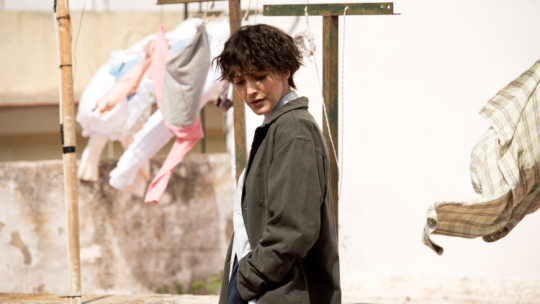
This week’s wide offerings don’t seem particularly strong with Blake Lively starring in the political thriller THE RHYTHM SECTION (Paramount), along with Jude Law. Directed by Reed Morano, I wasn’t able to figure out what the movie was about from the trailer, but apparently, Lively plays a woman trying to get revenge on those who caused the plane crash that killed her family. Really, I don’t know much more about this movie except that it was supposed to come out last year sometime before being moved to this weekend in January, which may end up being a better slot for it, that is, if anyone cares to see Lively in this kind of role. But since I have seen it, here’s my review…
Mini-Review: I’ve never really been a huge Blake Lively fan, but it’s impossible to deny her talents as you watch her playing a glammed-down junkie-hooker who transforms herself into a hired assassin. I’m not sure there are many other actors in Hollywood who could pull off such a role in what’s a pretty decent “Bourne”-inspired revenge thriller. (The irony is that the movie is produced by EON, the producers behind the Bond movies, something that could be credited for achieving ssthe movie’s world-spanning storytelling.)
Lively plays Stephanie Patrick, a woman whose parents and siblings died in a plane explosion. There years later, she still feels responsible since she didn’t get on the plane with them, and she’s hit rock bottom until a journalist (Raza Jeffrey) finds her to tell her that the crash wasn’t an accident, instead a target of a terrorist bomber. Stephanie believes him enough to go with him but when he ends up dead, she goes looking for his mysterious source in Scotland, who turns out to be Jude Law, an ex-MI6 who trains her to kill, giving her information about the responsible terrorist ring, “U-17.”
It’s a fairly simple story, adapted by Mark Burnell from his own novel, but it’s also the type of story that could go horribly wrong – see Jennifer Garner’s Peppermint for proof. A lot of credit has to be given to filmmaker Reed Morano, who gives The Rhythm Section such a distinctive look and tone without ever losing sight of the tension needed for a movie like this to work.
The movie does start out a bit slow, so it requires a bit of patience until Law shows up, and there’s some fun interaction there, but it’s definitely more of a drama than it is an action movie, so you should go in with that in mind. After being trained, the film starts following Stephanie, as she takes the guise of a dead assassin and dons different looks to go on her deadly missions. Sterling K. Brown also brings a lot to the film as another one of Stephanie’s contacts.
Ultimately, The Rhythm Section is a better movie than many will be expecting, a solid political thriller that isn’t the thing we normally get from a wide studio release in January. The pacing and some of the artier choices by Morano might not make it the most accessible film to everyone, but there’s no denying how it effectively pulls you in with the story and Lively’s performance.
Rating: 7/10
If that isn’t your cup of tea, there’s also the horror-fantasy GRETEL AND HANSEL (U.A. Releasing), directed by Oz Perkins (The Blackcoat’s Daughter) and starring It’s Sophia Lillis in a decidedly different horror role, but obviously, she gets the top billing in this take on the Hans Christian Anderson fairy tale, which I’m not 100% sure will be screened for critics. (At least I wasn’t invited to see it, so what else is new?) I can see how this might interest people more than last week’s The Turning, but it just doesn’t feel like that many people will feel the need to go to the movies.
Oh, it’s also Super Bowl weekend. I literally have no idea who is playing and I’ve made other plans Sunday night, but it always tends to affect box office business on Sunday due to the Super Bowl parties and the fact that people might want to sit at home and watch TV commercials and movie trailers rather than go to the actual movies. (Shrug emoji.) Either way, Sony lucks out with a third weekend at #1 for Bad Boys for Life, something that certainly wouldn’t happen in any other time of the year.
This week’s Top 10 should look something like this…
1. Bad Boys for Life (Sony) - $17 million -50%
2. 1917 (Universal) - $9.5 million -40% (up .2 million and one place)*
3. The Rhythm Section (Paramount) - $9.3 million N/A (down .7 million and one place)*
4. Gretel and Hansel (U.A. Releasing) - $7.6 million N/A (up .4 million)*
5. Dolittle (Universal) - $6.7 million -45% (down .3 million)*
6. The Gentlemen (STXfilms) - $5.9 million -45% (up .3 million)*
7. Jumanji: The Next Level (Sony) - $4.6 million -37% (down .2 million)*
8. Star Wars: The Rise of Skywalker (Lucasfilm/Disney) - $3 million -48%
9. The Turning (Universal) - $2.8 million -60%
10. Little Women (Sony) - $2.5 million -45%
* UPDATE: A few updated prediction based on actual theater counts including 1917 getting more theater this weekend that should help it retain second place over Black Lively’s The Rhythm Section. Also, Orion Pictures is pushing Gretel and Hansel into almost 3,000 theaters, so it should be good for fourth place unless Rhythm Section doesn’t click or connect with Lively’s fans.
LIMITED RELEASES
It’s always exciting (at least to me) when the annual OSCAR NOMINATED SHORT FILMS (ShortsTV) are released theatrically, since it gives everyone (at least in select cities) a chance to see all the shorts that were nominated, and it gives you a little more chance to do well at your office Oscar poll. This year’s selection has a much shorter run than usual, since the Oscars will be held on February 9, about ten days after the short films are made available, so don’t drag your feet on these. I rarely get to watch many shorts over the course of the year, unless I’ve been called to be a juror at a film festival, so it’s nice to at least get to see 15 shorts every year that are considered the best of the best.
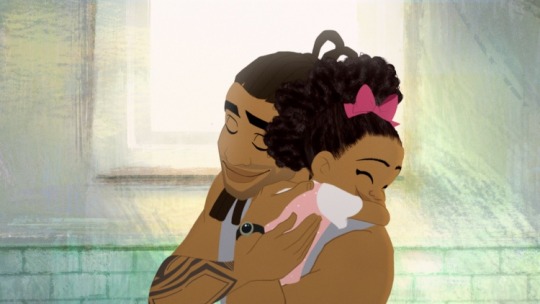
I tend to be most interested in the animated shorts, and besides the five nominees, this section will include a few “highly commended” films. I’m pretty sure everyone who sees Matthew A. Cherry and Karen Rupert Toliver’s Hair Love is gonna love it, as it follows a young African-American girl’s attempts to tame her unruly afro with the help of her father. It’s such a wonderful short with a beautiful ending, and in my opinion, it’s also the best-looking of the nominees, maybe since it uses a more traditional animation style than the other films. I would be shocked if this doesn’t win the Oscar.
Kitbull, one of Disney’s Sparks Shorts involves the relationship between a cute black kitten and a pitbull, a nice wordless film in the Pixar vein. It’s too adorable not to be considered as a possible spoiler in this category. sThe French animated short Memorable from Bruno Collet deals with a painter suffering from dementia, and it uses a fairly unique stop-motion look and style. On the other hand, I found the style used in the Czech film Daughter from Daria Kashcheeva to be rather jarring as it deals with the relationship between a father and daughter trying to heal, while the Chinese animated short Sister by Siqi Song actually deals with a similar topic as the fantastic short-listed docOne Child Nation, although it also uses a somewhat strange style. (Actually, I didn’t realize that Sister was stop motion, but I went to a dinner where I got to meet Ms. Song’s “actors.”)
The doc shorts tend to be the longest of the three groups with shorts ranging from 20 to 40 minutes, so these will often be broken up into two programs for viewing.
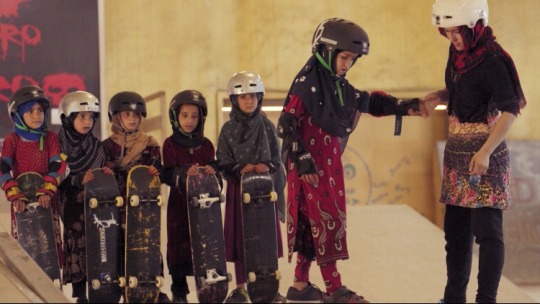
Learning to Skateboard in a Warzone (If you’re a Girl) clearly has the most self-explanatory title of the doc shorts, and it’s also the most likely to win, not only due to its memorable title but also the adorable little girls in bright-colored dresses who attend “Skateistan,” a school for girls who aren’t allowed to be outside due to Afghanistasn’s strict Muslim rules. (This is shown as part of Program A along with Life Overtakes Me.)
MTV’s St. Louis Superman, directed by Smriti Mundra and Sami Khan, is probably the most likely as a spoiler in this category, as it follows Ferguson activist and state rep Bruce Franks Jr. as he tries to fight back against gun violence both on the political floor and as a battle rapper.
The Korean doc In the Absence documents a horrifying ferry accident that kills hundreds while the proper authorities drag their heels in saving people, while the Swedish doc Life Overtakes Me, directed by John Haptas and Kristein Samuelsons, deals with refugee children in Sweden who, in the grips of trauma, get an illness called Resignation Syndrome, so it’s also quite timely.
Lastly and definitely not least is Walk, Run, Cha-Cha, the New York Times doc short directed by Laura Nix (Inventing Tomorrow), that’s a beautiful story of a couple who were separated by the Vietnam War but reunited years later and are now dancing together in California. It’s a beautiful film and story that might not be as groundbreaking as some of the others but is still quite wonderful and romantic.
At least the live actions shorts are more consistent in their timing with movies between 15 and 25 minutes, but they also offer equally international offerings.
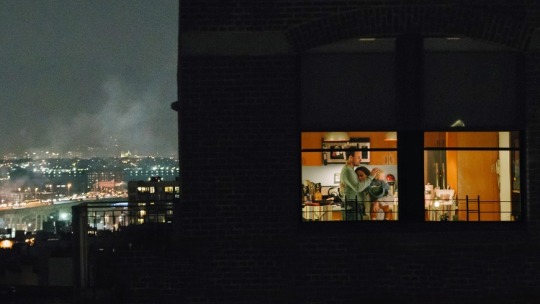
The Neighbor’s Window is three-time Oscar-nominated documentarian Marshall Curry’s first narrative effort, and it deals with a Brooklyn couple with two kids who get neighbors across the street who seem to enjoy a bit of exhibitionist sex, making them feel older. It’s a nice dramatic short that allows Curry to use The National’s music once again. (As I learned when I interviewed himin 2010, he’s friends with singer Matt Beringer.) The film takes a sad turn towards the end, but it’s a fine foray into narrative filmmaking and also, a strong PSA about buying drapes.
Bryan Buckley’s Saria takes place at a Guatemalan orphanage for girls where the title character wants to escape with her older sister to America. It’s actually based on the true story of a fire at the Virgen de La Asuncion Safe Home in Guatemala that took 41 lives in 2017 but from the viewpoint of these young teenagers. The movie is not necessarily about the fire as that happens at its very end, though this is definitely my favorite short of this group, dealing with a lot of tough (but extremely timely) issues, so I honestly think it might win the Oscar in this category.
Oddly, there are two shorts that take place in Tunisia and involve shepherds (sort of) with Meryam Joobeur’s Brotherhood involving a father whose son Malik returns home from Syria with a new wife. I found this one to be pretty dull and not particularly worthwhile. Slightly better is Yves Piat’s Nefta Football Club, whichfollows two boys who find a mule carrying drugs. (That is, an actual mule, not a person acting as a mule.) It’s a decent short with a fairly comedic ending, but I don’t think it has much of a chance of winning either.
The Belgian short Une souer (translated as “A Sister,” not to be confused with the animated short Sister) by Delphine Girard involves a kidnapped who makes a phone call to an emergency service and tries to make her whereabouts known without giving it away to her assailant. It’s a pretty decent thriller that does a lot in a short amount of time (about 16 minutes), but I don’t see this as something that might win the Oscar.
You can catch the Oscar-Nominated Shorts in select cities starting today and then slightly wider starting Friday, and then they’ll be available via streaming next week on Tuesday, Feb. 4
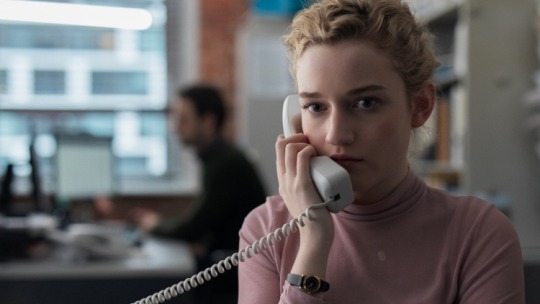
Julia Garner from “Ozark” stars in Kitty Green’s THE ASSISTANT (Bleecker Street), a movie about a young woman named Jane, who is working as an assistant at a busy New York distributor/production house based in the Tribeca area that couldn’t possibly be referring to the Weinstein Company, could it? I had pretty high expectations for this film, having heard about it as far back as last year’s Sundance where it premiered, and yes, while it is extremely timely, the cinema verité method that Green uses to tell the story of Garner’s character doesn’t make for a particularly interesting movie other than a few interactions, like one with Matthew Macfadyen as the company’s HR person when Jane reports her worries about the boss’ actions (nothing done to her, mind you). I do like Garner as an actor though, and I can’t wait to see what else she does post-“Ozark.”
At least the next film put up by its country for the Oscars’ “International Film” category was shortlisted, but it’s nowhere near as good as The Traitor (in my opinion). The Russian Oscar selection, Kantemir Balagov’s BEANPOLE (Kino Lorber), starring Viktoria Miroshnichenko and Vasilisa Perelygina as nurses Iya and Masha, working at a veteran’s hospital in Leningrad shortly after World War II. Iya is an extremely tall, lanky blonde woman referred to as “Beanpole” (hence the title) who also has a condition where she’ll freeze up at the most ill-opportune times. She’s taking care of a young child, who most presume to be her son but is actually Masha’s illegitimate son. The problem with this movie is that 20 minutes into it, something absolutely horrifying happens, and it just goes downhill from there. It’s not a bad movie but it’s one that’s really hard to watch, especially as Iya decides to do something to help her friend Masha, for reasons I don’t really want to spoil. Anyway, if you thought the sex scenes in the Brazilian offering Invisible Life were awkward and uncomfortable to watch, you haven’t seen a thing!
Hitting the Quad Cinema on Friday, the Laemle in L.A. on Feb 7 and other cities to follow is the Guatemalan film José (Outsider Pictures), directed by Li Cheng, and starring newcomer Enrique Salanic as the title character, a closeted gay man who lives with his mother in Guatemala City, surviving on selling sandwiches at bus stops. Unfortunately, Salanic was denied an entry visa, so he won’t be able to attend the film’s New York premiere, but Li Cheng will be doing QnAs at the Quad all weekend.
Also, Bong Joon-ho’s Parasite is getting a “black and white” release this weekend, because… well, who knows why anyone does anything anymore?
STREAMING AND CABLE
If you weren’t at Sundance, you can sit back, chillax and watch the Taylor Swift doc Miss Americana on Netflix (as well as in select theaters but who would want people to know that they’re a Taylor Swift fan? So just stay at home and watch it since Netflix won’t report its box office either way.) There’s also the new Norwegian superhero series Ragnarok, which launches its first season this Friday and that might be more my speed.
Hitting Disney+ this week is Jon Favreau’s The Lion King, which I still haven’t seen, as well as a few other movies. Also, Robert Rodriguez’s Alita: Battle Angel will debut on HBO this Saturday night, and “Veep” creator Armando Iannucci’s new series “Avenue 5” will premiere its pilot on HBO’s streaming platforms starting Friday.
REPERTORY
Before we get to the usual theaters, I’m thinking of adding a few new ones (well, not that new as they’ve been around for ages), for instance, the Anthology Film Archives, which is pretty much in my neck of the woods are having a series called “The Devil Probably: A Century of Satanic Panic” starting on Friday night, complete with an appearance by Lucien Greaves, spokesperson and co-founder of the Satanic Temple, who will hold a black mass ritual and give a lecture before showings of Benjamin Christensen’s Häxan and Penny Lane’s 2018 doc, Hail Satan? (which is about Greaves.) Other movies in the series include The Black Cat (1934), The Seventh Victim (1943) and classic thrillers Rosemary’s Baby (1968) and Race with the Devil (1975), as well as Terrence Fisher’s The Devil Rides Out (1968). (This week, the AFA is also showing late founder Jonas Mekas’ 1962 film Guns of the Trees with other Mekas works at least through Thursday!)
NITEHAWK CINEMA (NYC):
Okay, we might as well initiate another new addition, the Brooklyn theater with two locations, one in Williamsburg and the other in Prospect Park. The Williamsburg will be showing David Slade’s excellent 2005 film Hard Candy, starring Patrick Wilson and Ellen Page on Friday night as well as L.A. Story, starring Steve Martin and Daryl Hannah on Saturday and Sunday. On Thursday night, Prospect Park will screen Stanley Kubrick’s The Shining(1980) but mostly will be focused on new films.
Now back to our regularly-scheduled rep theaters, including my personal fave…
METROGRAPH (NYC):
The Metrograph is beginning a theatrical run of a 35mm print of Martin Scorsese’s 1977 film New York, New York, starring Bobby De Niro and Liza Minelli, and while it’s the closest thing to a musical Scorsese has directed, it acts more as a biopic for the writing of the classic song, “New York, New York”… kinda. This was not my favorite movie when I first saw it in theaters as a kid, and it hasn’t improved that much with age although this is a great era for Minelli, just a few short years after she won the Oscar for Cabaret. (That was one of the main reasons I saw it when it first hit theaters.) It also should be of interest to those who want to see De Niro when he was young enough to look like his de-aged self in his latest collaboration with Scorsese in The Irishman. But if you thought that movie was long then this movie’s 2 ½ hour run-time is also a killer.
I was pretty thrilled this last weekend to see so many young people enjoying the movies of Hal Hartleyat the Metrograph’s retrospective, and this weekend, it will continue with Hartley’s best-known trilogy starting in 1997 with Henry Fool, which was followed up with Fay Grim (2006)(which I wasn’t a big fan of) and 2014’s Ned Rifle(which I never saw). This weekend will also see Hartley’s The Girl from Monday (2005) and a number of shorter films.
Another series starting Friday is To Hong Kong with Love, for the theater’s continued Lunar New Year, celebration, which runs through the month of February. This weekend we get Peter Chan’s Comrades: Almost a Love Story from 1996 and Christopher Doyle’s Hong Kong Trilogy from 2015.Welcome To Metrograph: Reduxcontinues on Thursday with another screening of Edward Yang’s 1991 film A Brighter Summer Day. On Saturday night, the Safdies are presenting a screening of Adam Sandler’s The Wedding Singer from 1998.
This week’s Late Nites at Metrographis Brian de Palma’s Scarface (1983), starring the one and only Al Pacino! Also, THIS WEEKEND, Playtime: Family Matinees is showing Taika Waititi’s excellent 2016 film Hunt for the Wilderpeople on Saturday and Sunday morning, so I expect to see you all there, at least on Saturday, which is when I’m attendings.
ALAMO DRAFTHOUSE BROOKLYN (NYC)
As mentioned last week, tonight’s “Weird Wednesday” is something called Killer Nun, and there’s also a sold-out Big Lebowski Movie Party. Next Tuesday, the Alamo is showing Michael Haneke’s 2002 film The Piano Teacher, starring Isabelle Huppert, and then “Terror Tuesday” is the 1977 horror film, The Sentinel. (Apparently, the Anthology isn’t the only New York theater on a satanic kick.) Next week’s “Weird Wednesday” is the “Lone Wolf and Cub” classic Shogun Assassin from 1980. (There will be two showings… one at 7pm and another at 9:30!) Also, on Monday, you’ll have another chance to see Takashi Miike’s Audition (1999), although that’s also almost sold out.
THE NEW BEVERLY (L.A.):
Weds’ afternoon classic is Sidney Lumet’s 1976 classic Network, and then Weds and Thurs. nights, you can see a triple feature of Orca (1977), Nightwing (1979) and the horror film Prophecy (1979),which is a pretty amazing trilogy. Friday’s “Afternoon Classics” is Friday the 13thPart V: A New Beginningfrom 1985. Friday night’s Midnight offering is Tarantino’s Django Unchainedwhile the weekend Kiddee Matinee is Harry Potter and the Sorcerer’s Stone from 2001. Wes Anderson’s Moonrise Kingdomwill screen as a matinee on Monday.
FILM FORUM (NYC):
The Forum’s “Black Women” series continues this week with a number of movies including Dorothy Dandridge in Island in the Sun (1957) on Friday, Tarantino’s Jackie Brown on Saturday, along with Pam Grier’s classic Foxy Brown, which inspired it. Sunday is The Color Purple and more through the weekend, including Hal Ashby’s 1970 film The Landlord screening on Sunday and Monday night. This weekend’s Film Forum Jr is The Incredible Shrinking Man from 1957 in a 4k restoration.
EGYPTIAN THEATRE (LA):
The Egyptian has been busy screening Oscar movies, trying to get some Academy members in to see them before voting next week. Cinematic Void 2020 continues this weekend with the Giallo film Strange Shadows in an Empty Room (1977) on Friday, then Joe Dante’s 16mm spotlight screens This Is Not a Test (1962) on Saturday, and then the Marx Brothers comedy Horse Feathers shows on Sunday in 35mm, and then that afternoon, they’ll screen Putney Swope, the 1969 film directed by Robert Downey Sr. and My Dinner with André (1981).
AERO (LA):
Thursdays “Films of Marty and Bob” matinee is Mean Streets (free to Cinematique members), and then on Friday, it’s “Ford vs. Capra” as Mr. Smith Goes to Washington and Young Mr. Lincoln (both from 1939) screen as a double feature. Saturday is a “Ford vs. Spielberg Double Feature” of The Searchers (1956) and Saving Private Ryan (1998). Sunday is a suitably-timed “Super Dust Bowl Double Feature” of Ford’s The Grapes of Wrath (1940) with 1942’s The Ox-Bow Incident.
MOMA (NYC):
This week’s Modern Matinees: Jack Lemmonare Glengarry Glenn Ross (1992) on Weds, Costa-Gravas’ Missing (1982) on Thursday and the 1995 film The Grass Harp. MOMA is also doing an “American Indies, 1980 – 1989” series that will screen Charles Burnett’s My Brother’s Wedding (1983) and Steven Soderbergh’s sex, lies and videotape (1989) on Weds, John Waters’ Polyester (1981) and Bette Gordon’s Variety (1983) on Thursday, Jarmusch’s Stranger than Paradise (1984) and Wes Craven’s A Nightmare on Elm Street (1984) on Friday, as well as the Coens’ Blood Simple, Wayne Wang’s Chan is Missing and Lizzie Borden’s Born in Flames over the weekend.
FILM AT LINCOLN CENTER (NYC):
Milos Foreman’s One Flew Over the Cuckoo’s Nest (1975) will screen on Thursday as part of FilmLinc’s New Wave event for new members in their 20s and 30s. Oh, you young people get all the good stuff and yet, you still complain about everything. What’s up with that?
IFC CENTER (NYC)
Waverly Midnights: Hindsight is 2020s is James Cameron’s Terminator 2: Judgment Day yet oddly, the other two ongoing series are taking off this weekend. I wonder why. Or maybe they’re just showing some of the same-old-same-old like The Shining, Suspiriaand reshow of Cuaron’s Children of Men. (Plus they’re showing the Oscar-nominated shorts and other Oscar nominees in many theaters.)
MUSEUM OF THE MOVING IMAGE (NYC):
In conjunction with its 2001: A Space Odysseyexhibition, MOMI has a series called “Influencing the Odyssey: Films that Inspired Stanley Kubrick and Arthur C. Clarke,” this weekend showing Metropolis (1927), Forbidden Planet (1956), The Day the Earth Stood Still (1951) and Ikarie XB1 (1963). 2001: A Space Odyssey will also screen again on Saturday.
ROXY CINEMA (NYC)
This week’s Nicolas Cage offering on Weds is 2002’s Windtalkers, which I remember liking even though it’s probably not good. They’re also showing Cage’s Gone in 50 Seconds remake (co-starring Angelina Jolie) on Thursday.
LANDMARK THEATRES NUART (LA):
Ooo… this Friday night’s midnight screening is a good one, one of my favorite movies of the last decade,Edgar Wright’s Scott Pilgrim vs. the World (2010), starring Michael Cera and Mary Elizabeth Winstead (who is also in next week’s wide release)!
Next week, Margot Robbie stars in Birds of Prey: And the Fantabulous Emancipation of One Harley Quinn, and honestly, that might be one of only two or maybe three times I type out that annoyingly-long impossible-to-remember title!
0 notes
Text
“Baywatch” (2017)
Action/Comedy
Running Time: 116 minutes
Written by: Mark Swift & Damian Shannon
Directed by: Seth Gordon
Featuring: Dwayne Johnson, Zac Efron, Priyanka Chopra, Alexandra Daddario, Kelly Rohrbach, Jon Bass and Ilfenesh Hadera
Mitch Buchannon: “Welcome to Baywatch. Our team is the elite of the elite. We’re the heart and soul of this very beach. We protect when other people don’t want to protect, and we go above and beyond.”
The assault on the idea concept of comedy in movies continues with the release of the remake or reboot or whatever you want call this comedy abomination that is “Baywatch” (2017) out this week on DVD & Blu-ray.
Now I wouldn’t have said this movie was doomed from its announcement, especially with the early word that Dwayne Johnson was involved, someone who is not afraid to laugh at himself as well as carry a movie that needs some very big shoulders to support it. Its unfortunate then that the studio that released this, Paramount, decided to stick Johnson with a director as well as screenwriters that seem to have no clue to what they are working on. They also seem to have no idea on how to use their secret weapon, who is normally a charmer as well as someone who can deliver almost any kind of dialogue all while inviting the audience to come with him on some kind of journey – here however none of that works, so we have what must be one of the worst movies of the year so far, along with many other comedies that have missed the mark by a mile.
The movie starts out in Emerald Bay, Florida, Lt. Mitch Buchannon and his team of lifeguards, including second-in-commmand Stephanie Holden and veteran C. J. Parker, protect the beaches and the bay as part of an elite division known as Baywatch. Having made over 500 rescues in his career, Mitch is beloved by the community, to the annoyance of local beat cop Garner Ellerbee and Mitch’s superior, Captain Thorpe.
At the upcoming tryouts for new lifeguards, three people stand out: surfer Summer Quinn, an old friend of Holden’s, Ronnie, a chubby nerd with a crush on C. J. (that is gradually returned), and Matt Brody, a former Olympic swimmer who fell from grace after vomiting during a race and now has to perform community service as part of an unspecified plea deal. Quinn and Ronnie both pass the trials, but Brody refuses to do so and insists that his celebrity status alone entitles him to a place on the team. Despite Brody demonstrating his abilities by assisting in the rescue of a drowning woman and her son, Mitch complains to Thorpe that he is unfit. Thorpe, in turn, insists that rehabilitating his image is necessary to convince the city not to further cut Baywatch’s funding.
From here the plot if you could call it that becomes needlessly complicated as well as extremely crass, as it stands for no really good reason.
I have complained about the lack of good comedies that have been released this year, and “Baywatch” has to top the list of not only being humourless, but it even manages to mishandle the action elements that may have saved this from being extremely tiresome to watch – I watched this at home and found myself hoping for the end to come, it meandered from one tireless set up to the next without seeming to go anywhere at all. My feeling was that no-one really committed to a genre so each aspect of this movie is underwhelming.
Normally any movie, especially one that relies on personality or has to because the plot is absent, that has at its center Dwayne Johnson, is already ahead because he is just so charismatic as well as being able to make fun of himself means that he can be on the audiences side as well as being in on the joke. One need only look at the “Fast and Furious” franchise to see he is one of the only actors actually hamming it up, making those dreadful movies bearable for those of us that like the over the top nature that is inherent within those movies. “Baywatch” the movie, has not earned that so we are just looking at Johnson as part of this film not apart from it. The supporting cast is made up of both experienced as well as newish actors that all come off as one note and not appealing at all. So we have Alexandra Daddario, Zac Efron and Priyanka Chopra struggling with a plot as well as trope filled exposition while appearing alongside newbies Kelly Rohrbach, Jon Bass and Ilfenesh Hadera really not coming to terms with the kind of movie they are in as well as having very little actual screen presence.
The argument could be made that there was a similar situation with the original television show with some experienced actors as well as some very average novice actors. My argument against that, as well as illustrating the superiority of the television version is that it was a different time, 1989 to 1999, the show knew exactly what it was and the talent in front of the camera was vastly superior to the people we have now. Here is some of the talent involved in the series and its an easy argument with time on our side that these actors have at least more talent as well as huge screen presence than that of this poorly attempted translation, we have of course David Hasselhoff, Parker Stevenson, Billy Warlock, David Chavert, Alexandra Paul, Erika Eleniak, Pamela Stevenson and many many others. If there was a small percentage of their presence in this movie it would have been a far better watch.
Its not only in front of the camera where mistakes have been made, the writers (which is a generous title), Damian Shannon and Mark Swift, have only had two somewhat other successes, if they could be called that, which were the middling horror re-imagining (I am being kind) “Friday the 13th” (2009) and “Freddy vs. Jason” (2003). Both of these movies are genre pieces and are just updating other people’s work, which may have been the appeal here, but sadly there is nothing they have added to “Baywatch” to even make it remotely interesting. So it is here where the director should make some decisions to enhance what is a lackluster script, but this is where the inexperience of Seth Gordon shows. Sure he had a hit with “Horrible Bosses” (2011) but misfired with “Identity Thief” (2013) then in between has directed a lot of comedy televison which means he was trying to learn how to direct narrative on the fly, which again shows here in this movie, where he was probably stuck between his script his producers as well as his actors – I am not envious because what we have been left with is a mess of a film both narratively as well as plot wise with an inconsistent tone as well as a R-rating slapped on to make it seem edgy – which it is not.
The filmmakers needed to pick a tone and style then follow through on that, I can see why they chose some kind of action/comedy route, which worked well with the redo and big screen adaptation of the hit “Starsky and Hutch” (2009) but there you had writers, a director and most importantly stars who could handle the material and knew not only what they were doing but also what they were doing. This is yet another misfire from the studio Paramount who have not been able to buy a hit this year and the slate for the rest of the year looks dire as well.
This is definitely not worth a purchase and to be honest even if you could watch this free it is unlikely you would enjoy it; in fact if you watched it on a plane you would not be forgiven for walking out.
“Baywatch” is out on DVD & blu-ray now.
Blu-ray & DVD review: “Baywatch” (2017) “Baywatch” (2017) Action/Comedy Running Time: 116 minutes Written by: Mark Swift & Damian Shannon Directed by: Seth Gordon…
#baywatch#blu-ray#bluray review#bluray reviews#dvd#dvd review#DVD reviews#DVDReviews#dwayne johnson#seth gordon#spry film#spry film review
2 notes
·
View notes
Text
Gotham City Sirens - Who should play Catwoman & Poison Ivy?
In the ever-expanding DCEU, one of the announced films likely to garner some excitement from fans is that of GOTHAM CITY SIRENS. Technically it'll act as a spin-off of last year's SUICIDE SQUAD which introduced us to the first big screen version of Harley Quinn, played by Margot Robbie.
SUICIDE SQUAD 2 is in the works, as is a spin-off for the film's lead DEADSHOT, which should see the return of Will Smith, I think most are looking to the comic book adaption that will see Margot Robbie return, both as a lead of sorts, and in a producer role.

Of course, Harley Quinn will be just one third of the female lead team - the other two being Catwoman and Poison Ivy. So, basically, the best known female villains in Batman's "Rogue Gallery".
There's even the suggestion we might get Batgirl's introduction into the shared universe. But, for now, lets focus on the main trio. We know Robbie will be back as Harley, but who will be cast as her partners-in-crime?
Below are a few suggestions on who could join the franchise.
CATWOMAN
So far, Catwoman has been the highest profile female character in the Batflicks to date. Lee Meriwether played her in the camp sixties effort BATMAN: THE MOVIE, whilst we got an iconic turn from Michelle Pfeiffer in Tim Burton's BATMAN RETURNS. We won't discuss Halle Berry's venture (we don't need to - it wasn't Selina Kyle, so it's not relevant) but the last time we saw Catwoman on the big screen was in Christopher Nolan's trilogy-capper THE DARK KNIGHT RISES, played by Anne Hathaway.
But who should don the catsuit for this new generation of batfans? Here are seven options.
LENA HEADEY

Lena recently put her name in the ring, on twitter, when asked why she hadn't already been asked, and it was a question she asked too. So, that's why she's on the list. Right now she's the ONLY name that's even been remotely linked - and the GAME OF THRONES star wouldn't be a bad choice. At 43, she's the right age to fit with Affleck too. (We have nothing to say that Affleck will be anywhere near the film, but in the grand scheme of things, it's relative).
KATE BECKINSALE

My personal favourite at this point, I'd say. All you need to do is look at the UNDERWORLD franchise to see she, at the very least, looks the part). She also happens to be 43, which fits with 44 year old Affleck.
ANGELINA JOLIE

You can't deny there's something somewhat feline about Jolie, and she'd certainly be a high profile casting. I actually think she's make a good Catwoman, and - again - she's in the right age range. Of course, Jolie may not want, what is likely to be a very physical demanding role, and she's now trying to carve a career as a director. Still I thought it was worth suggesting her.
NATALIE DORMER

Okay, I'm just putting this one out there in case Warner Bros. decide to go younger. At 35 she's still pretty much a decade older that Robbie, but would look in-keeping I think. She was a fan favourite for CAPTAIN MARVEL for the MCU (she's already had a small role over there, though) and she's the second GAME OF THRONES actor on this list, as well as appearing in THE HUNGER GAMES franchise.
EVA GREEN

Eva seems to be the fan choice at the moment, and it's hard not to see why looking at some of her turns, such as PENNY DREADFUL and SIN CITY 2. She also about the same age as Dormer. Now, I won't lie, Green wouldn't be my choice, but I've seen so many other suggest her, I felt I had to include her on this list.
MILA KUNIS

Okay, Mila is easily the youngest on this list, in her early thirties, and perhaps is too young for "Affleck's Catwoman", but she's still be older than Robbie, and I feel fits the Catwoman role. She looks the part, and I reckon could play the part. I've not seen her in a role similar, the closest being JUPITER RISING, which wasn't maybe the best example. I'm still waiting for Kunis to break out with a franchise.
THANDIE NEWTON

Another name I've seen put out by fans (nearly as much as Green), and Newton is certainly in the public eye following the success of the recent WESTWORLD series. I certainly prefer her to Green, and think she'd bring a performance somewhat reminiscent of Eartha Kitt in the 60s show.
As I said, Beckinsale is my personal choice, but I could see all of the above seven options working to some degree. I think the general thought is, if any of the characters are, Catwoman (presumably Selina Kyle), will be the elder of the three leadies, keeping to Affleck's age. However, fans seem to have it in their heads that Poison Ivy will be younger. This may well be the case, too, but I hope to provide a mix of ages below.
POISON IVY
Ivy was played by Uma Thurman is the below par BATMAN & ROBIN, and didn't get a gritty real revamp during Nolan's trilogy. This will be DC's chance to rectify the damage.
CHRISTINA HENDRICKS

I have thought Hendricks to be a perfect fit for Ivy since I saw her in FIREFLY, and seeing her in MAD MEN and LOST RIVER certainly hasn't made me change my mind on the matter. She's easily my top choice. Again, in her 40s, she's just the right age range with Affleck.
ISLA FISHER

I love Isla Fisher. I make no apologies for her appearance in the list. She's probably too cute for the role, and she perhaps doesn't fit the 'superhero' look all the actors seem to have... but I wanted to throw her name in the ring. I would be ecstatic of she was cast! (Again, perfect age!)
ALEXANDRA BRECKENRIDGE

A name I've seen pop up a few times in fan's wishlists. A nice surprise too. I've not see her much, personally, having only really noted her as the sexy maid in AMERICAN HORROR STORY and as Jessie in THE WALKING DEAD, but I'd definitely consider myself a fan... I'd be more than happy to see Breckenridge cast as Poison Ivy.
ALEXANDRA DADDARIO

Another name from fanlists, and an interesting one. I think she went to the top of most fanboy lists following *that scene* from TRUE DETECTIVE. I think the new BAYWATCH film won't turn either. That said, for Ivy, I'm not sure she would be my pick. When Marvel were looking for JESSICA JONES, she was my pick for that, and was even a little disappointed when she lost out, so I want her to get a franchise - just not sure it's Ivy. I won't complain if she did get cast though! At 30, she's one of the youngest actor on this list.
JESSICA CHASTAIN

I've not seen Chastain on any fan-lists yet, which is surprising in itself, considering almost all other redheads are featured. I actually think Jessica might be a good fit for Poison Ivy. Whether or not she'd fit in with Margot's Harley is another matter. She's quite intelligent (remember, Ivy was a scientist), but she can handle action (as witnessed in THE HUNTSMAN: WINTER'S WAR).
KAREN GILLAN

Gillan will be known to you for one, maybe two, things. Right now, she's best known for playing the blue and bald beauty, Nebula, in GUARDIANS OF THE GALAXY. If you know your sci-fi, and like British sci-fi, then you'll also know her as Amy Pond in DOCTOR WHO. Now, it's quite possible, I'm only putting her in this list because she's ginger. But I don't care. I'm not sure she'd be allowed to join the DCEU, considering her role in the MCU is still ongoing, but I'm going to include her here. So there. (she's also, the youngest on this list, and I think would look great alongside Robbie).
AMANDA SEYFRIED

I'm going to be honest with you, I was going to put Emma Stone on the list, then crossed her out in favour of Jane Levy, but am now resting on Amanda Seyfried. I think she's got a unique look, that might not immediately offer itself to being a supervillain... or maybe it does... but I'd like to see Amanda pop in one of the big superfranchises, and reckon her Poison Ivy would compliment Robbie's Quinn.
So, there you are, 14 options. But before you pick your favourite, I'd like to offer a bonus 15th...
ALISON BRIE

I'm offering Brie as a bonus, because I'd like to suggest her for either role - I could see her as either Catwoman or Poison Ivy. She's been up for roles in the MCU (she lost out to Emily VanCamp to play Sharon Carter in CAPTAIN AMERICA: THE WINTER SOLDIER), and she's been garnering a fanbase, appearing in a number of films, and of course she's well known for playing Annie in COMMUNITY. She's one I would certainly love to hit a franchise, and whilst I was thinking of her as a hero-type... why not a villain instead?
So, there you have it. Do you think any of my suggestions are likely to make the grade? Will we be seeing Margot Robbie, Kate Beckinsale and Christina Hendricks rattling around Gotham City in their own film? Or do you have a better option? Let me know!
#dceu#gotham city sirens#harley quinn#margot robbie#catwoman#poison ivy#batman#suicide squad#ben affleck#lena headey#mila kunis#christina hendricks#Kate Beckinsale#karen gillan#alison brie#eva green#thandie newton#jessica chastain#amanda seyfried#isla fisher#natalie dormer#angelina jolie#Alexandra Daddario#alexandra breckenridge
42 notes
·
View notes
Text
SUPERNATURAL THE ANIMATION: A Dissection of Dean’s Failed Characterization & Design (PART 1 - The Technicals)
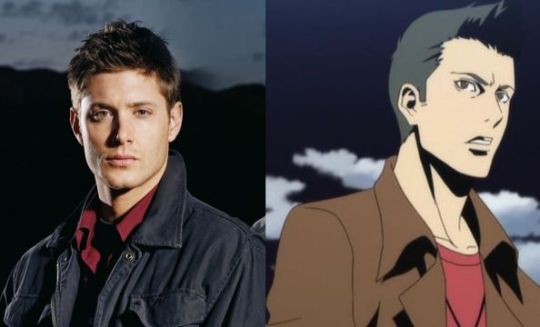
I have a lot on my chest about the anime that I couldn’t really get into in both of my last posts since the topic of what makes the anime series so cringe-worthy is a very intricate one, making the explanation of it all become a SERIES OF ESSAYS. So please read my previous installments before getting into this one because I will be referencing those a lot:
SUPERNATURAL THE ANIMATION: A THESIS OVERVIEW ON JAPANESE ANIME PRODUCTION & CHARACTER DESIGN
SUPERNATURAL THE ANIMATION: THE IMPORTANCE COLOR DESIGN BRINGS TO VISUAL TONE
But anyway, let’s talk about Dean. I’m gonna talk about Dean.
I will talk about Dean because Sam was portrayed pretty okay in the anime and it’s really Dean’s characterization that strikes a chord with a lot of fans of the original Supernatural series. (However I will consider a separate Sam essay to those in favor of it.)
But I haven’t really seen a lot of people put into words about makes them feel the way they do. So what’s the problem with Dean?
Refresher:
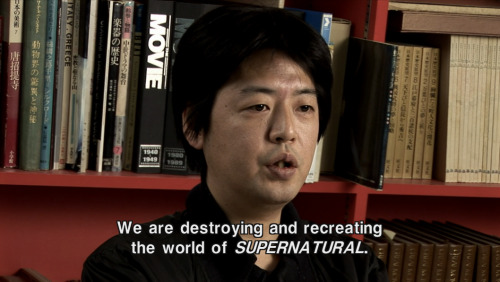
While I understand this distinction, I think that we can all agree that the overall interpretation of Dean suck balls and I’d like to argue that:
rather than misinterpreting Dean’s character, the writers were more focused on one of Dean’s major facades and ran with it.
But I’m getting ahead of myself.
First, I’d like to address the elephant in the room: Why an anime series?
Why did Supernatural garner enough attention to GET an anime series? What is so special about Supernatural AND anime that a large group of creatives and investors were willing to marry the two?
Honestly, that question is big enough for another essay on it’s own. But the bottom line is:
Anime is watched for the melodrama.
Nuance and subtitles are more akin to live action film since the culture around the different intricacies of a story have larger factors that contribute to it. (i.e, it doesn’t matter what’s written because an actor may just ad-lib it, Murphey’s Law, etc.)
So basically, when you have an animated show what you see is what you get by convention. There really is no use arguing over what is canon and what is not because, unlike an actor, decisions and change of mind can’t be attributed in the moment when it comes to character performance. People are more likely to question the mindset of a decision behind a scene when it’s animated more often than leaving it to the death of the author.
But it’s because of this that anime often has namely traits of exaggeration: screaming characters crying about their passion in the heat of battle, long ass internal monologues, “-dere” archetypes, the works.
Which means that anime characters are usually walking talking hyperbolic symbols. (Whether or not you enjoy this is usually the deciding factor between anime fans and those who are not.)
And this ties directly into Dean.
Because Dean in the anime series is an exaggeration of himself from the original show.
Rather, an exaggeration of one specific facade:
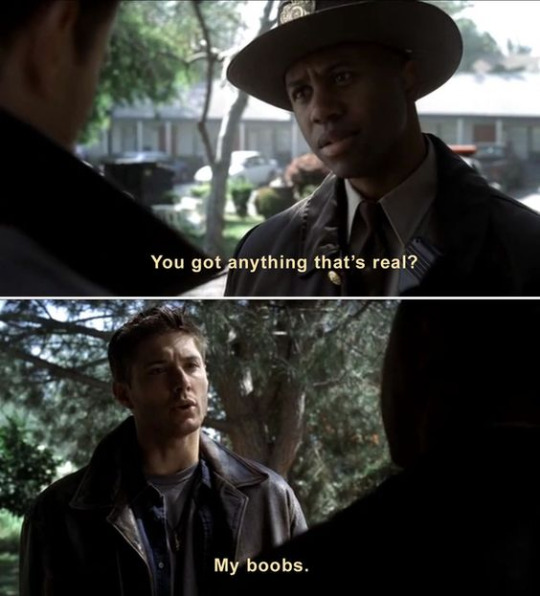
The facade Dean pulls up in season one episode 1. The fake Dean that tends to overcompensate his insecurities with bravado.
WHY this scene in particular is one that actually makes sense.
Mostly because this scene IS a if not THE root scene that cemented Dean Winchester’s starting point launching endless possibilities of character traits to be explored for seasons to come. It’s a highly impacted scene that’s very memorable, both in it’s first impressions and as a point of reference for his development.
I infer that the writers of the anime series saw this and built upon their own impressions of it. Namely, they saw this facade and thought this was the True Dean Winchester. (Which, to those who have watched past season 2, know is very far from the truth.)
So how did they write Dean Winchester?
Dean Winchester is perceived to be like a generic anime bad boy
(I say “perceived” since by all means the Supernatural anime is a reinterpretation with very deliberate changes.)
What I’m talking about are those “thug” type bullies in every school centered anime show.
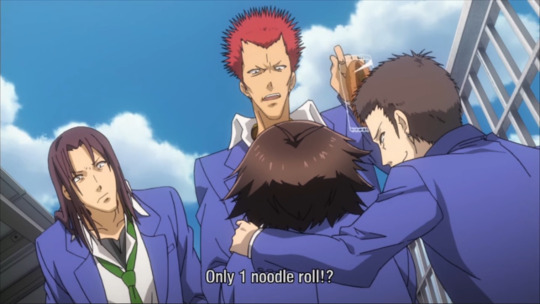
And while I make the claim that the writers may have built off of the scene from the pilot in painting a picture of Dean’s character in their heads, I’m also led to believe that this decision to have Dean come off as a “thug” is less of a conscious choice...
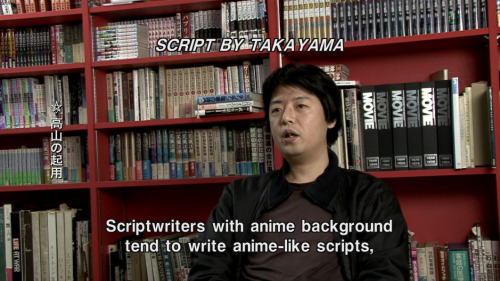
...and more of a conventional one.
Because nothing fits Fake Bravado Dean like Generic Anime Thug Dude when it comes to a script laden with anime-like tropes.
(To make a more compelling dissection of the writer’s true interpretation of Dean SPECIFICALLY would require me to rewatch and analyze ALL of the anime’s original standalone episodes.
...for the sake of brevity and the fact that I don’t want to rewatch any of the anime’s episodes in it’s entirety because I can’t stand even 5 seconds of this animated drivel I Am Not Going to Do That unless a lot of people ask about it or if people just wanna see me suffer.)
But okay, it’s sort of weird to gauge the errors of Dean’s characterization when this anime series nearly follows the original show’s 1st and 2nd season’s storylines verbatim.
Now that I think about it, it’s even weirder to be so allergic to an interpretation of a character when the source material is being 99.9% faithfully adapted--especially with the same lines and set up. So what gives?
What makes anime Dean’s characterization so off from the original to a drastic degree?
The “mischaracterization” is greatly tied into Dean’s character design and the way he emotes--which affects him greatly on the narrative of the anime series as a whole.
I already criticized the character designs in the lack of coherence in color design as well as execution narratively, but the latter still stands to be a huge major problem since it does just that.
Affect the narrative.
Which means it also affects the characters and the themes.
Which ties back again to Dean being perceived as an anime thug.
And I know this because Dean makes the same goddamn faces as an anime thug.
(In this case I’ll be referencing Space Dandy since I can’t find generic anime examples of side characters that embody this profile despite this stereotype and it’s mannerisms invading vast amounts of shows. However anyone who has seen enough anime will know what I’m talking about. And again, the “look” given by the artistic nuances/techniques of the character design of the anime series is not very original.)
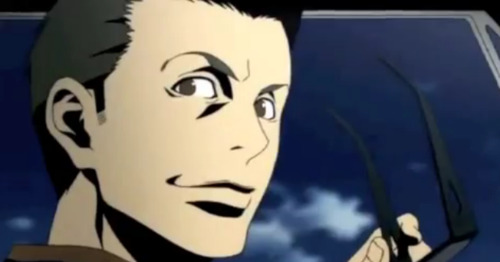
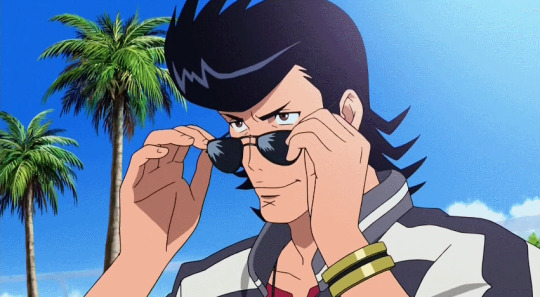
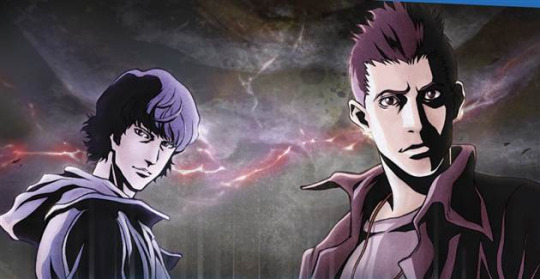
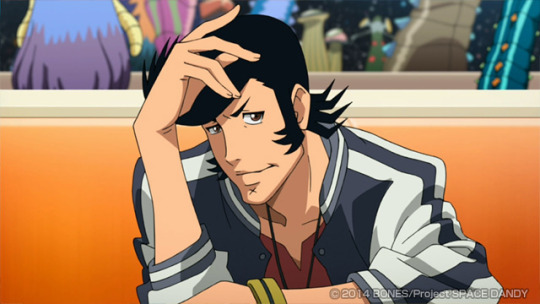
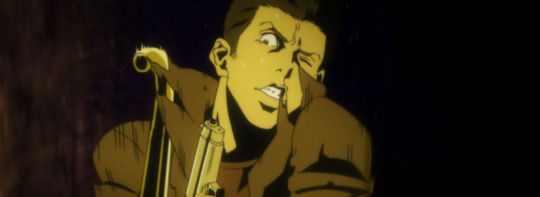

You know what, as an aside I’m just going to throw in the fact that Space Dandy’s “look” is very similar to to the spn anime down to the BL shadows in which Dandy is compared with Redline
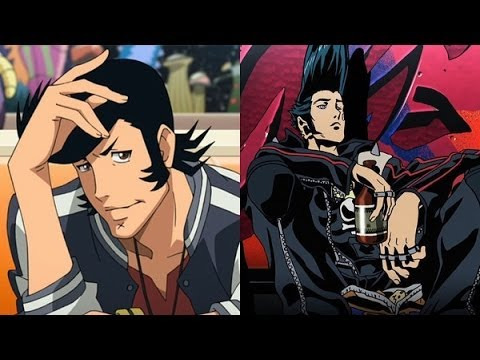
And that Jessica is totally generically designed

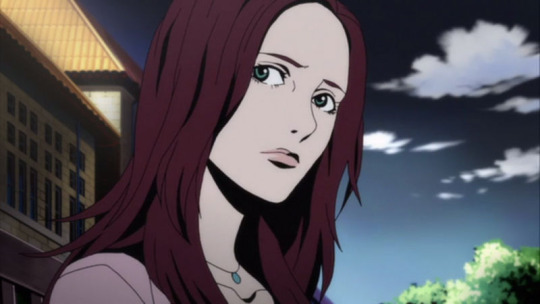
Anyway, this extends further than Dean’s facial expressions alone.
It extends to his wardrobe which totally starts to unhinge Dean’s persona. oddly enough.
So here’s a round of nit-picking
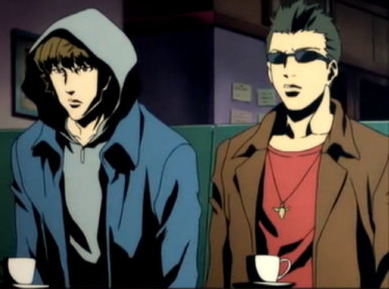
Why in god’s name is Dean wearing sunglasses indoors? He already went through an entire spiel about ineffectiveness at night
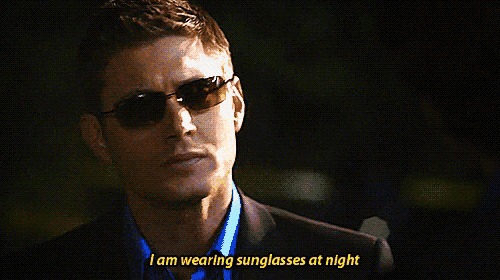
and it’s not like having it indoors makes it any less ridiculous. And yes, he does wear them again in later seasons both unironically and ironically
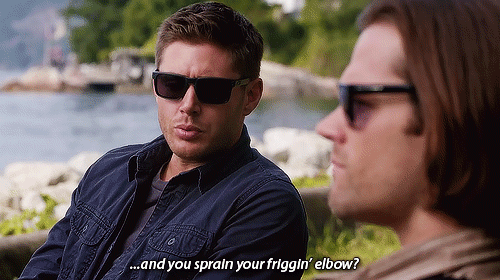
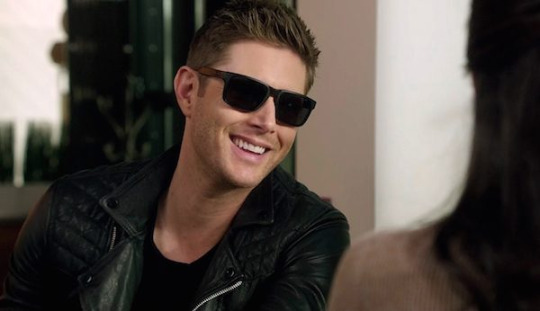
But these cues of character insight (that people have written far better meta for) is in the context of later seasons and I highly doubt the anime production team could’ve predicted any of this so I’m just going to have a giant ????? over this.
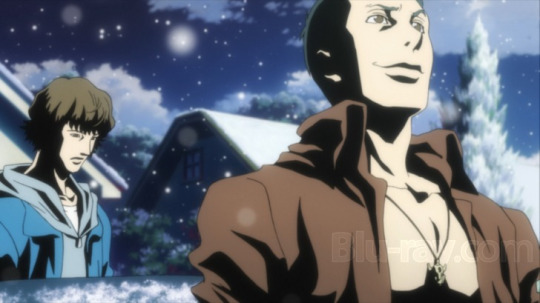
Back to this awful screenshot again.
But seriously, anyone shirtless in the snow deserves to die of hypothermia.
Dean is the last person to feel comfortable with minimal clothing due to years of sexual harassment/assault from CREATURES more often than not
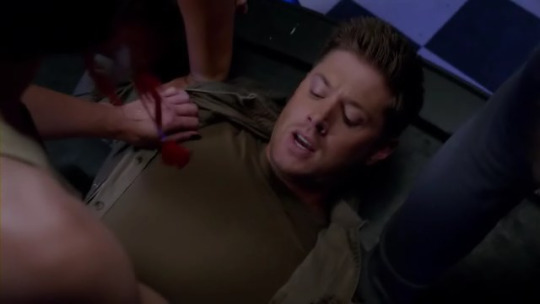
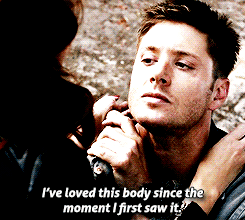
Even more so whenever Dean is naked, it’s used more for vulnerability over titillation:
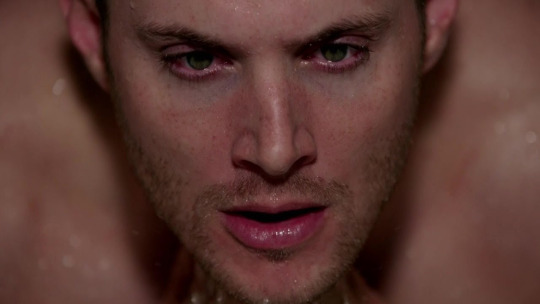
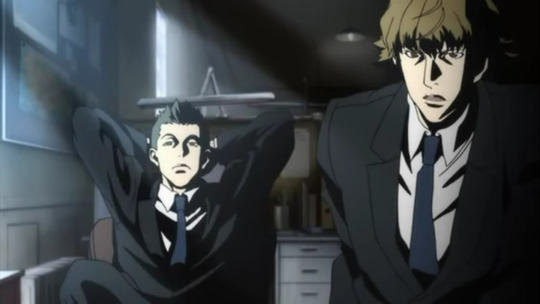
I hate this stupid screenshot.
It is awful, why? Because anime characters rarely stray from their trope mannerisms unless the story calls for it, or the animators dedicate some time to create impressive sakuga for novelty’s sake. If Dean has body language like this now, that mean’s he’s likely going to exhibit it again no matter what the context is in terms of story or character.

Leading to this abomination.
I know what you are doing. I get it. I KNOW.
I KNOW YOU’RE DRAWING DEAN THIS WAY BECAUSE APPARENTLY TO YOU DEAN IS AN ANIME THUG WHICH MEANS ANIME THUGS EXHIBIT THIS KIND OF UNCARING BODY LANGUAGE BUT NEED WE FORGET THAT DEAN LOVES HIS CAR MORE THAN LIFE ITSELF
HAVING HIS SHOES AGAINST THE SEAT OR ANYWHERE NEAR THE LEATHER IS THE SAME AS DEFECATING ON IT. ARE YOU SERIOUS RN??? THAT’S LIKE THE ONE THING DEAN WINCHESTER IS ALL ABOUT AND IS SOMETHING THAT SHOULD NOT BE FORGOTTEN ESPECIALLY WHEN IT CAME TO DEVELOPMENTS OF DEMON!DEAN
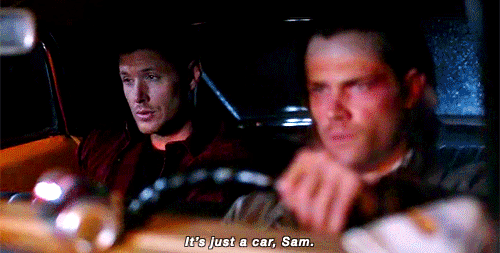
This...this shit I can’t forgive. This is so absent-minded it physically hurts me. I can’t be the only one bothered by this.

Addendum: I don’t even really care if that’s NOT the impala (in this episode of the anime Sam and Dean were thrown into the backseat of a police car.) I still don’t think Dean would EVER exhibit this sort of body language in any car.
It also still doesn’t excuse the lack of variety in Dean’s emoting and body language as a whole. You could do so much storytelling in his body language (since Jensen Ackles is a master at that) but they instead chose to stick with a template of a character and never strayed from it.
But...I digress.
Incidentally of all places Yuri!! On Ice has closer character designs of Sam and Dean that for some virulent reason exists (Also incidentally, if you so much as breathe the title of YOI you will be immediately blocked I am not joking around. Don’t test me.)
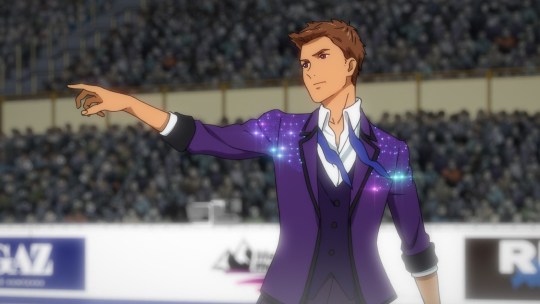
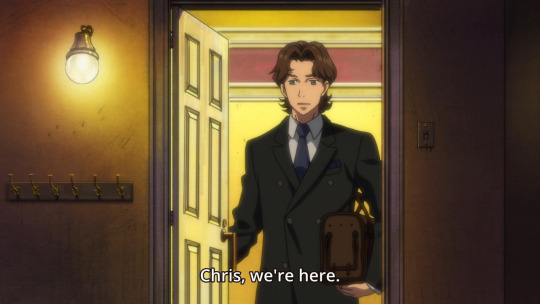
As does Yami Shibai
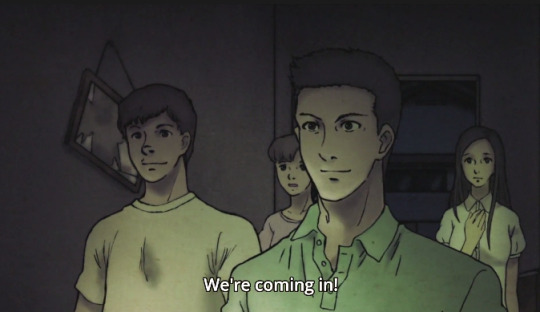
So it’s not like a competent/more modern design tailored to anime is impossible.
It is very possible. So if you have your defense that the character designs of the spn anime are inherently horrible BECAUSE it’s supposed to “look anime” you’re probably just suffering from media illiteracy.
However, again, I made claim that the “style” of the Supernatural anime character designs are not what make it fail.
It’s the execution of nuances that killed it--both visually and narratively. And I still stand by that.
To form examples, that means more design redraws!!!
However, the redraws this time around will have it’s own separate post since the inner working of what can make or break a design will be discussed and demonstrated there.
SEE YOU IN PART 2!!!
57 notes
·
View notes
Text
Post-EDM is the New Rock ‘n’ Roll
(photo by: Rukes)

For as long as I can remember, electronic music has always been one of the most creative and re-inventive art forms. Growing up with a dad, aunt, and uncle who all listened to it, I was exposed to a lot of unique stuff. I can still recall as far back as the emergence of tunes like ‘As The Rush Comes’ by Motorcycle or even techno remixes of the soundtrack for Legend of Zelda: Ocarina of Time. The entire prospect of electronic music that was always so cool to me was the seemingly endless possibilities behind the production. Electronic music brought us a new era of music that dates back to Donna Summers, and popularized the concept of a “remix”. Similar to bands covering another track, remixes were particularly huge to me as a listener because it opened new worlds of possibilities for new creations. It it that very potential energy that led me to begin producing music in the first place. And now here we are in 2017, and it seems everywhere you look, electronic music has expanded in the mainstream market. From producers like Zedd hitting the mainstream audience through pop radio airplay, to the adaptation of college culture to including music festivals like Ultra, it seems everything is beginning to focus on electronic music (or EDM, as the hipsters like to call it). And similar to how rock ‘n’ roll music blew up in pop culture, it seems EDM is doing the same. The great thing about this, which many of my older relatives fail to grasp, is that this era of music is going to completely shape not only the future of the music industry, but also society as a whole. Seeing as EDM has now become a focal point in the business world, entertainment industry, and even the economy, it’s important to understand what the evolution of this music could mean for the future. All signs suggest this music has reached a breaking point, and we’re nearing a new phase: post-EDM. It wasn’t until a recent op-ed from vocalist/producer Anna Yvette that I realized such a thing existed. However, as I looked into it, it began to make a lot of sense. Artists like Deadmau5 and Daft Punk have long been known to have unique live performances in that they aren’t strictly playing a track-to-track set. However, more recently there’s been a surge of new artists creating live performances of electronic music with more intuitive sets and more involved musicality. My first show I can recall of such was in 2014 when I attended a show for Porter Robinson’s Worlds Tour. It was the first show I had ever attended that provided EDM through live performance, namely piano, drums, and vocals. Porter somehow managed to provide a very similar experience to being in a club, while also maintaining the feel of seeing a live band. It was revolutionary to me, and while some may argue that it wasn’t original, it was the first of its kind to reach the audience it did. To emphasize the impact this interpretation of dance music had on the industry, within just 2 years of that show I have since attended 4 separate shows in which the artist was conducting their entire performance through live instruments and visuals. These shows were also each from different artists. Haywyre, Madeon, Elohim, and Eden all provided live performances, and the list could go on to include Echos, Zedd, Crywolf, Illenium, Flume, and Jai Wolf (although I was unable to witness those). Quite frankly, it seems there’s a growing wave in this trend. More artists are adapting to this concept of live electronic music, and it’s introducing great ideas beyond the music. Elohim, for example, uses her live show to tell a cohesive story written through her debut album. Her lyrics gracefully present anxiety and other mental illnesses in a light that can be discussed more openly and confidently. Madeon and Porter Robinson use the live platform to create innovative mashups of music from two separate discographies, enabling the comfort that electronic music is about love and acceptance instead of competition. Whether you’re a fan of these new interpretations of dance music, or simply not bothered to leave the festival scene, it’s inevitable, regardless, that there is a unique and captivating energy about post-EDM. And now that EDM has reached the audience it has, it’s only a matter of time before post-EDM takes full effect. While it may seem like just a fad, there is a lot of hope for this era and what it will bring to communities of differing political opinions, communities of philanthropy, and even pop culture. As of now, Porter Robinson’s tour single with Madeon, ‘Shelter’, was re-produced as an anime short film through massive production companies A-1 Pictures and Crunchyroll, and has garnered over 13 million plays on YouTube alone in just 4 months. If that doesn’t make a statement about the impact of this music, I’m not sure much else will. It’ll be interesting to see which artists decide to go the new route and implement this art form. After years of seemingly monotonous pop culture trash (read: excluding amazing acts like Lady Gaga), it’d be cool to see someone like Flume or Elohim make the Super Bowl halftime show. Only time will tell. Below you can find a Spotify playlist of my favorite post-EDM music: Listen here
#post edm#rock n roll#edm#motorcycle#anna yvette#deadmau5#daft punk#porter robinson#haywyre#madeon#elohim#eden#project#echos#zedd#crywolf#illenium#flume#jai wolf#shelter#super bowl#lady gaga#pop#music#rukes#ultra#a-1 pictures#crunchyroll#donna summers#live
1 note
·
View note